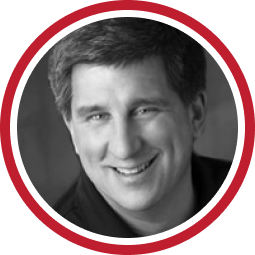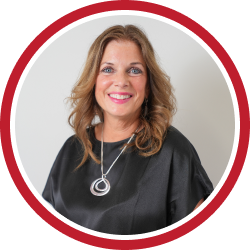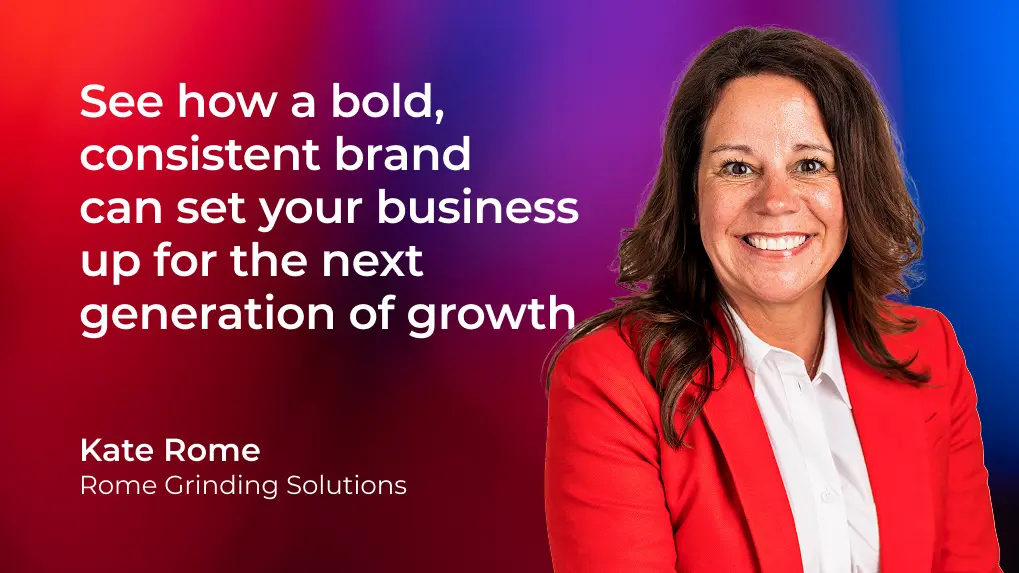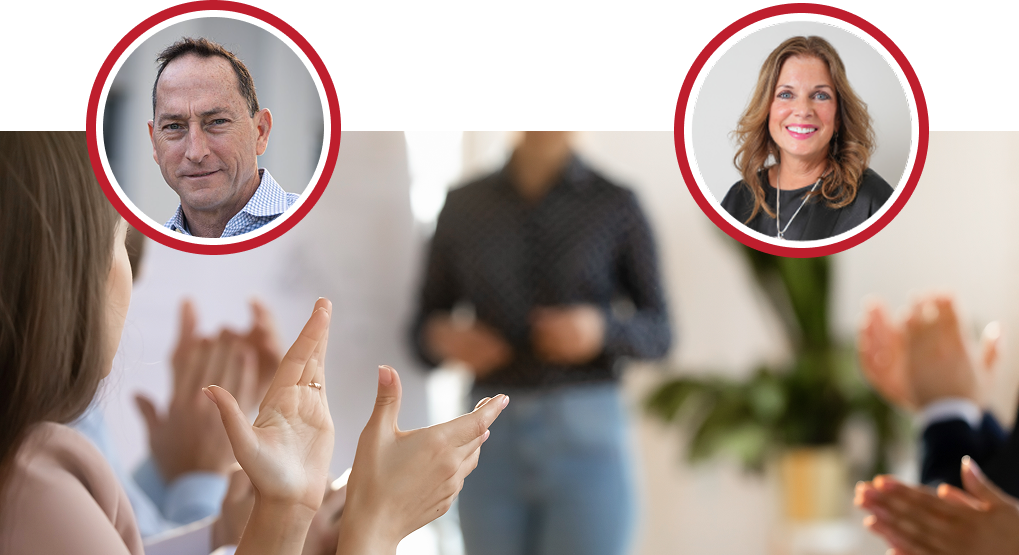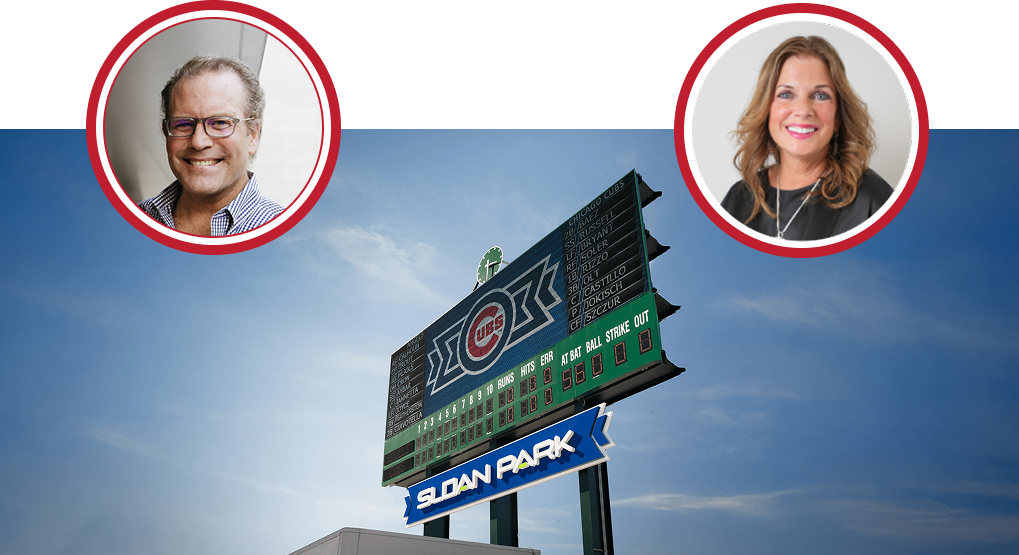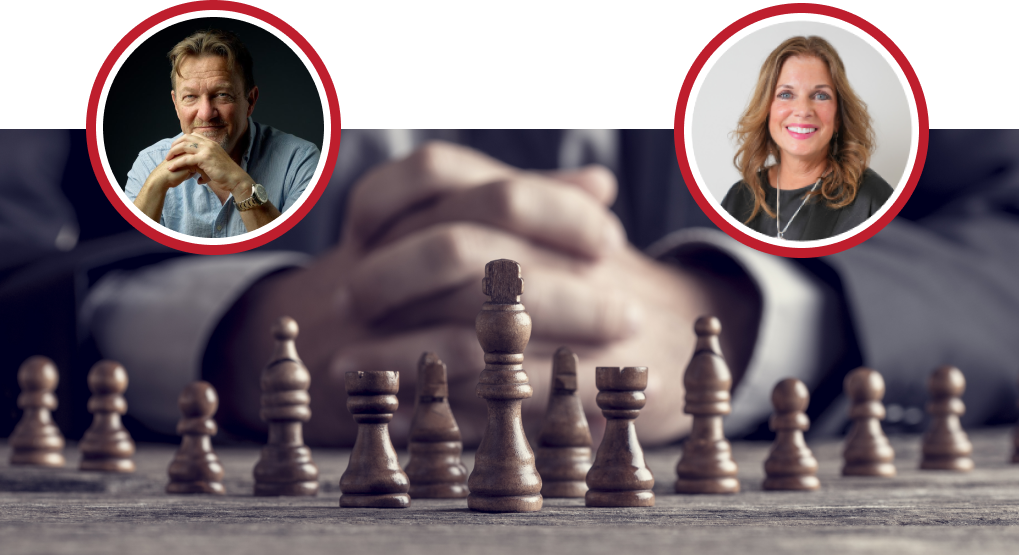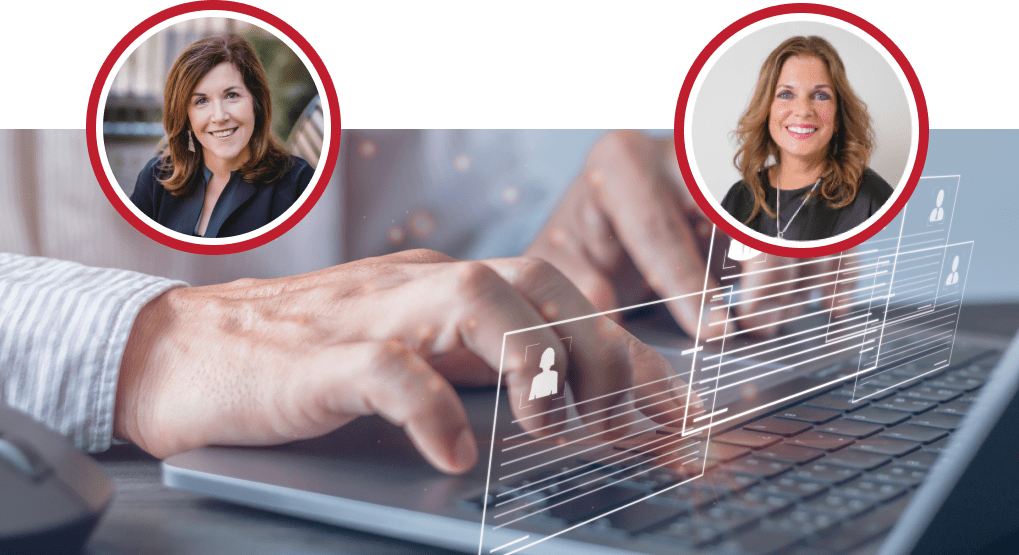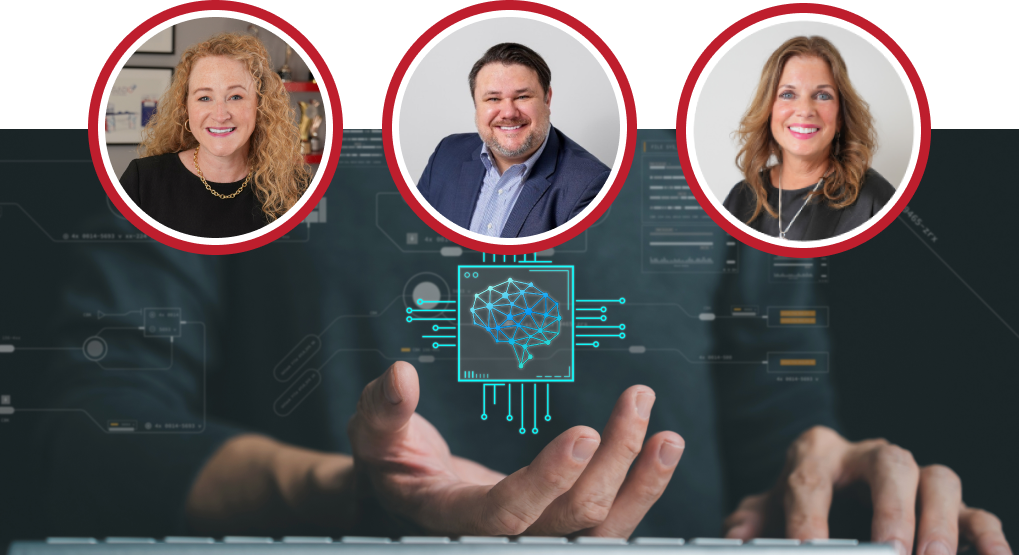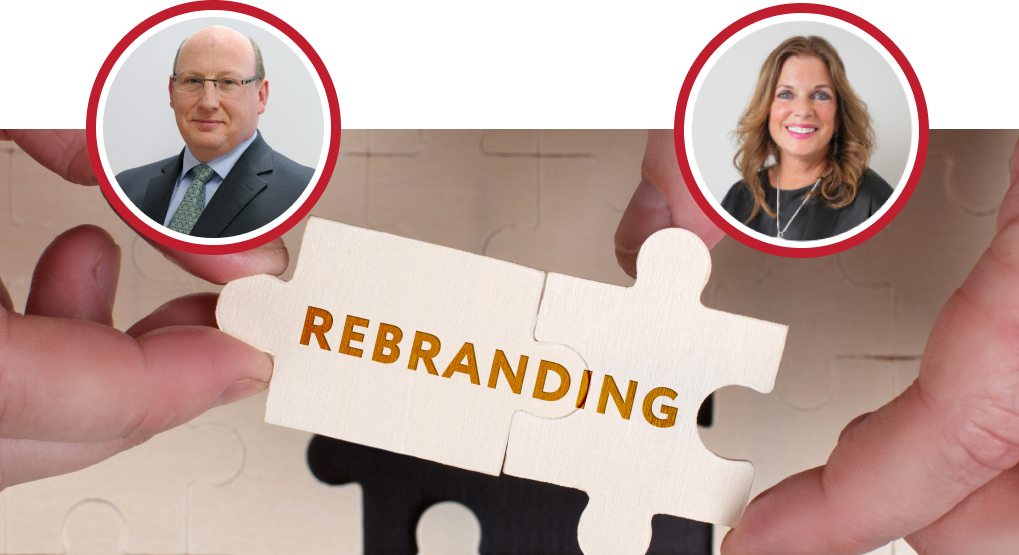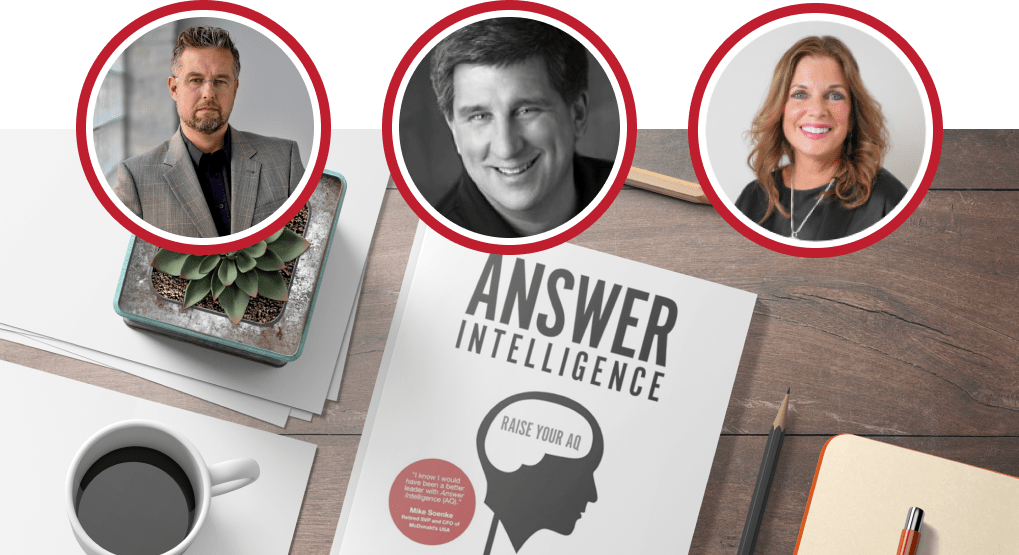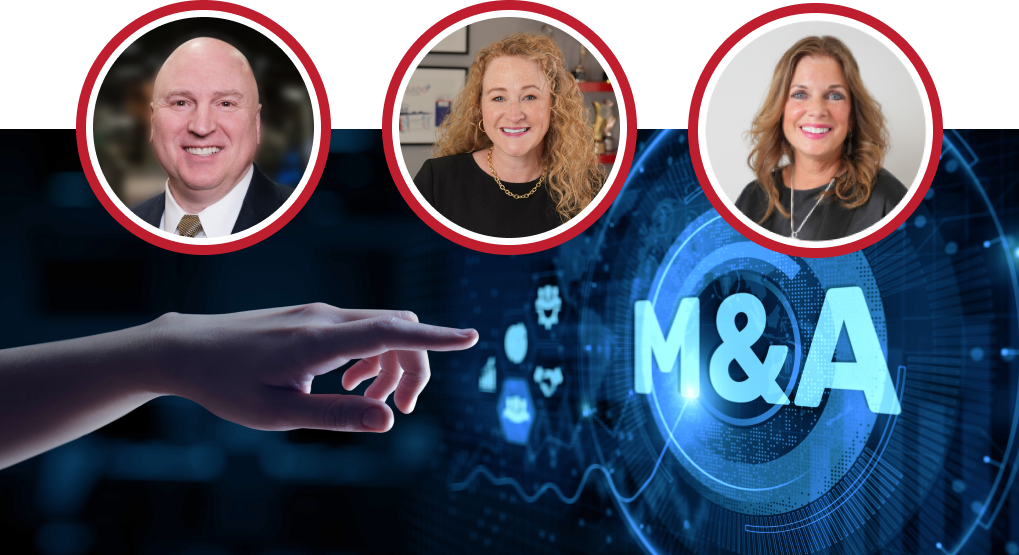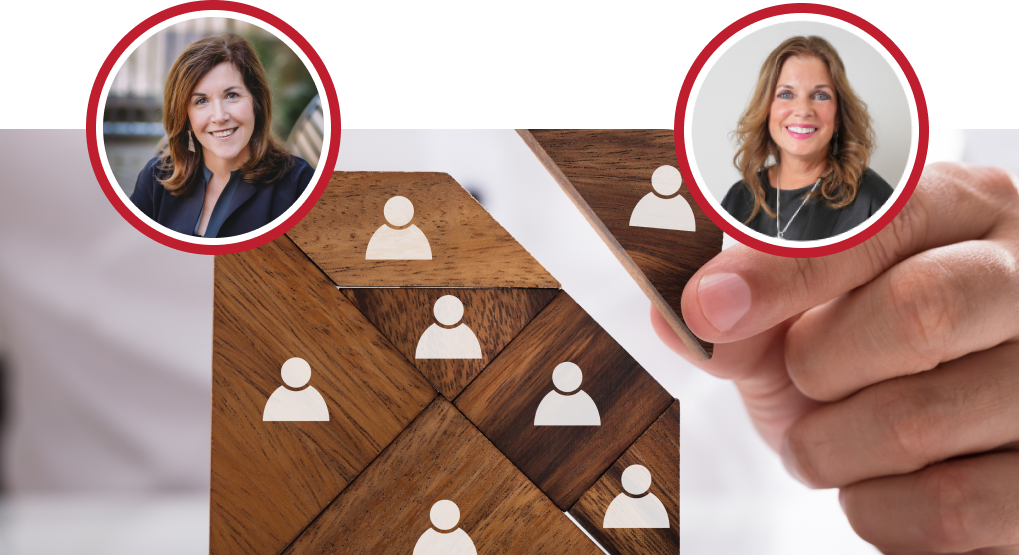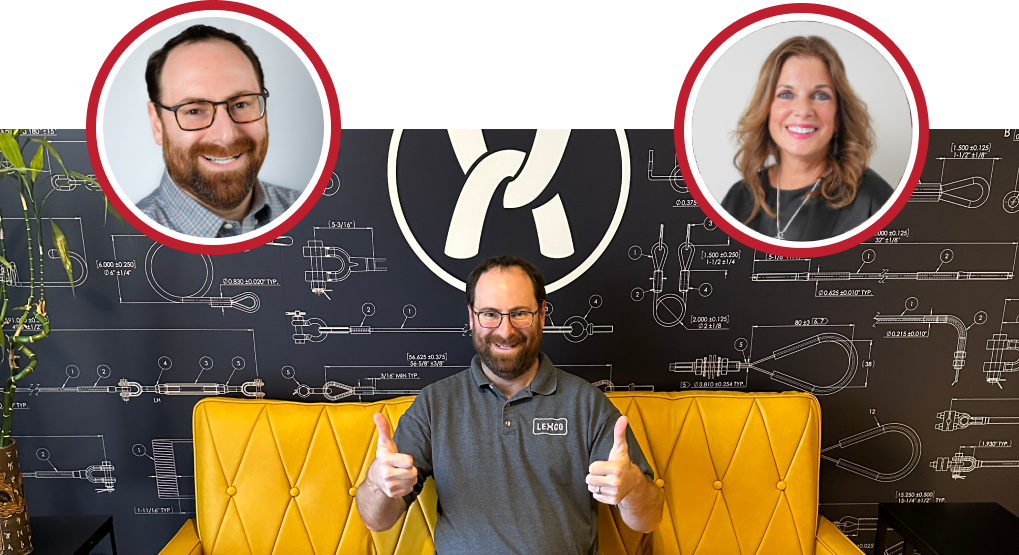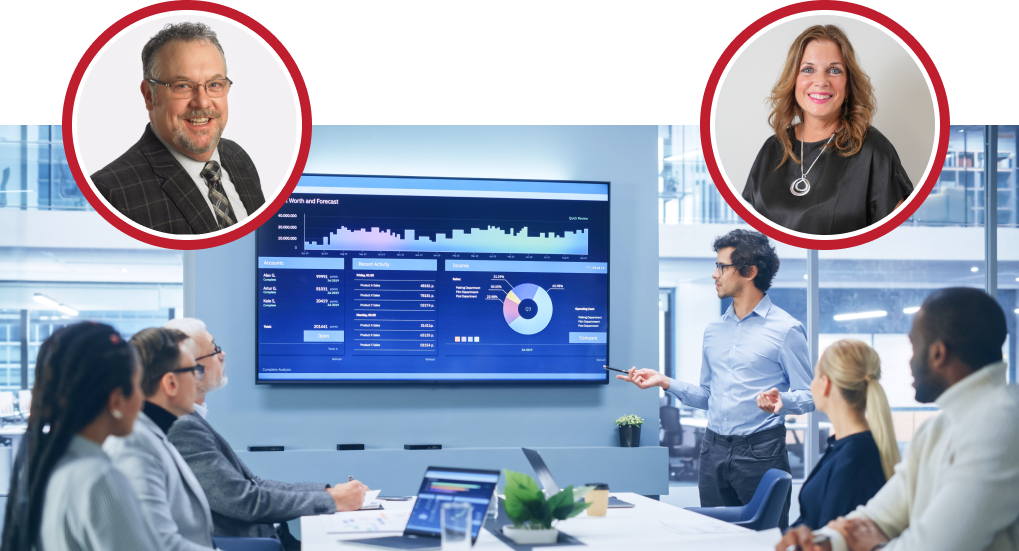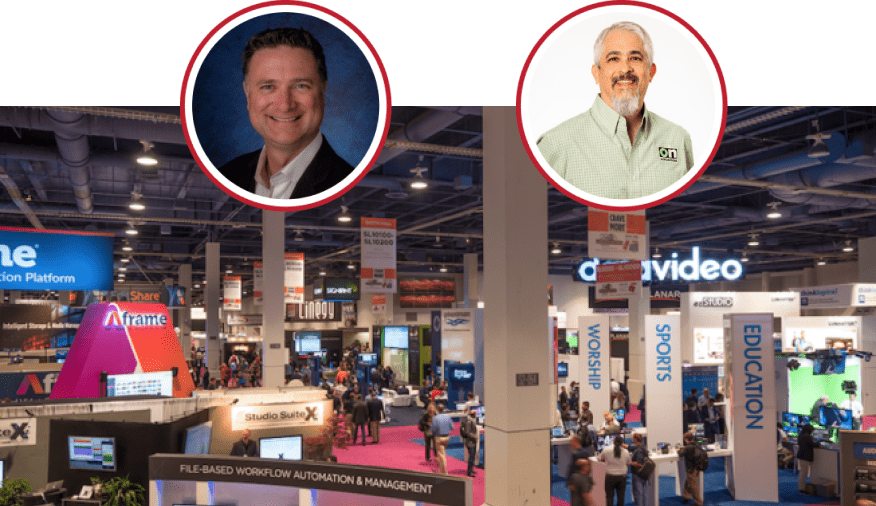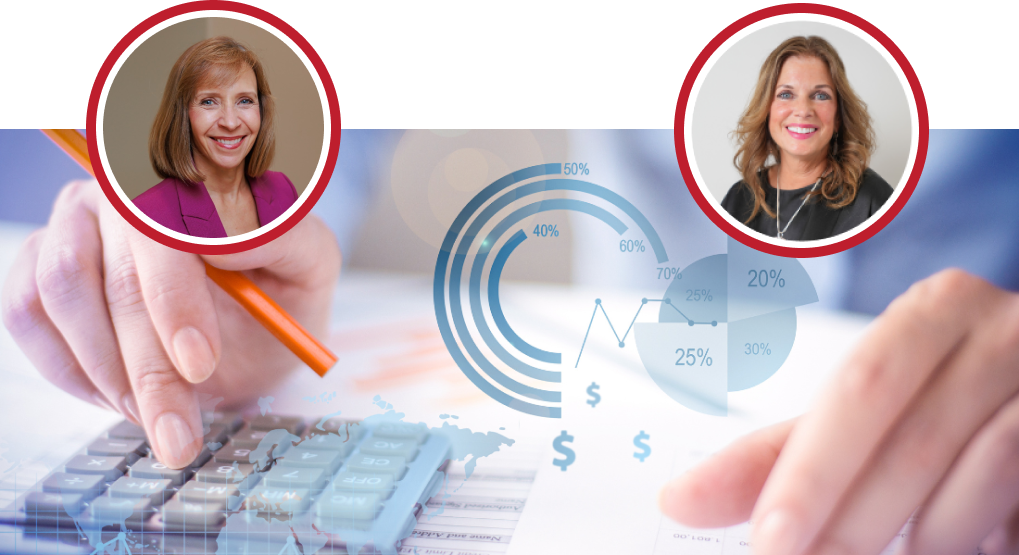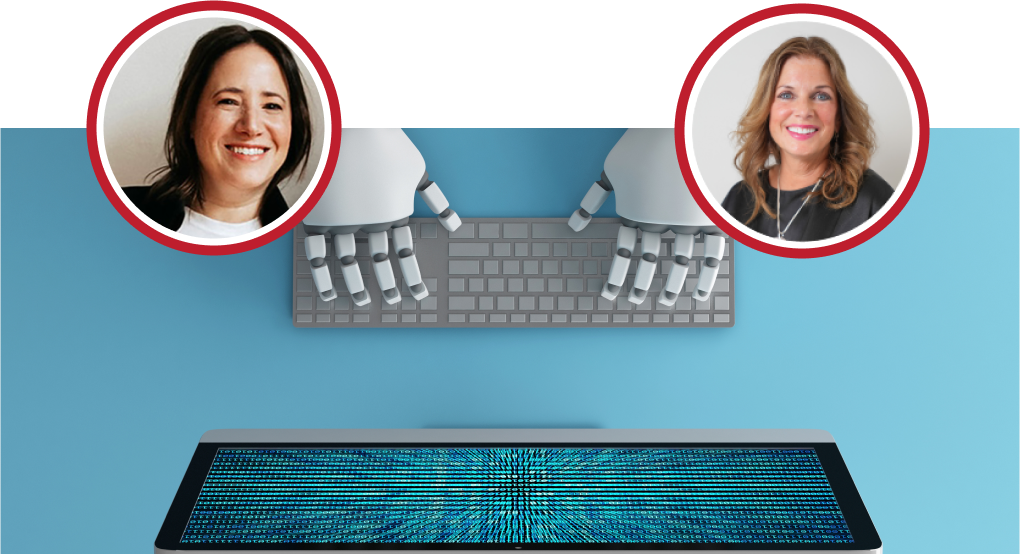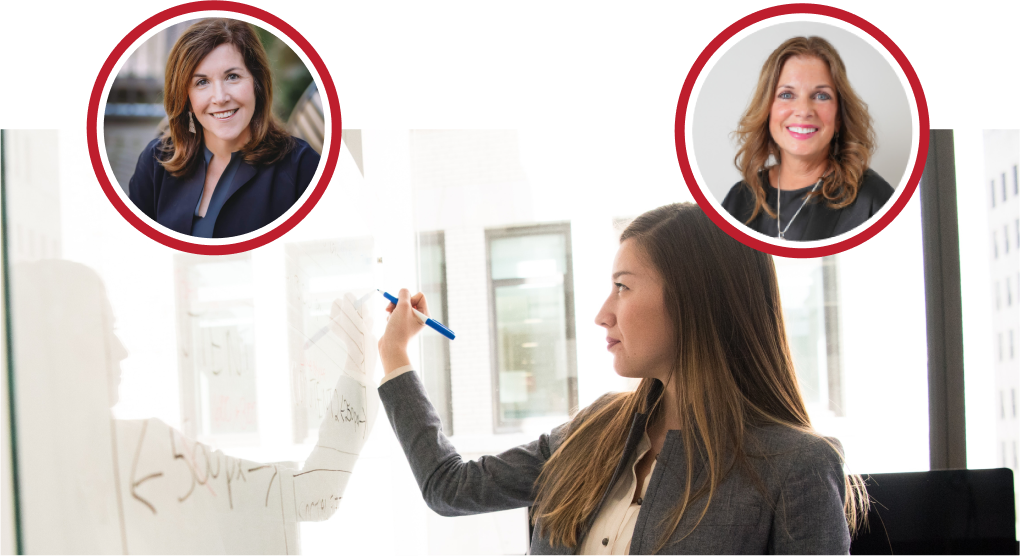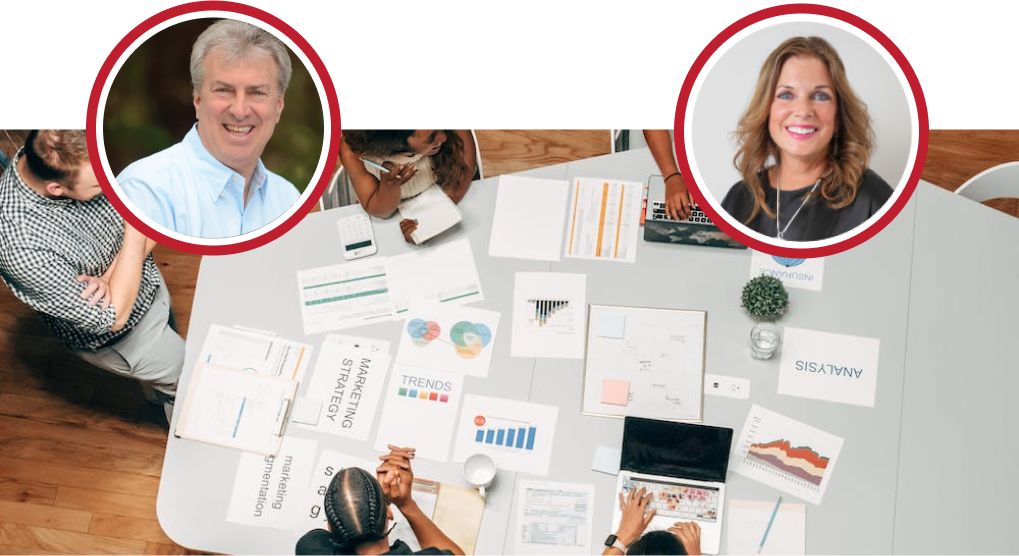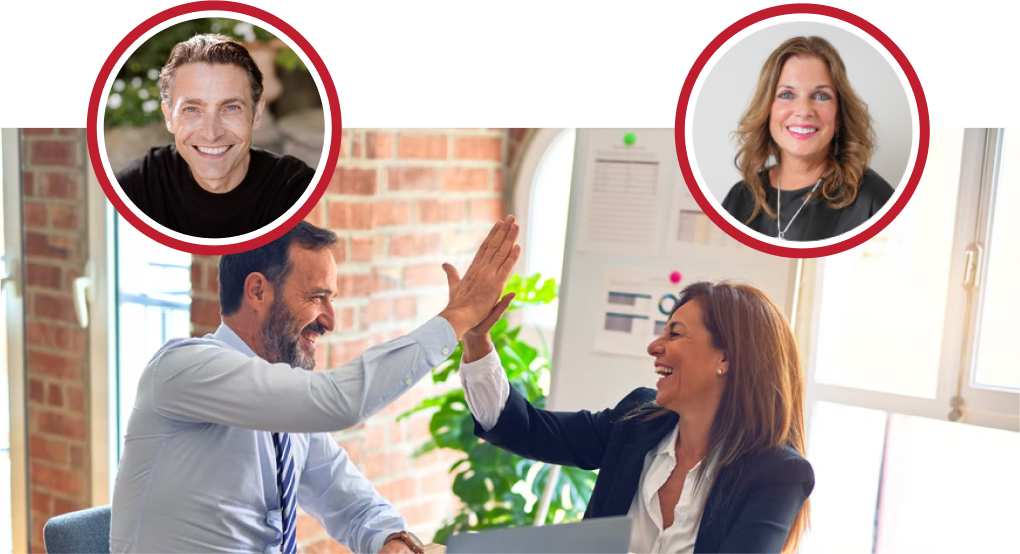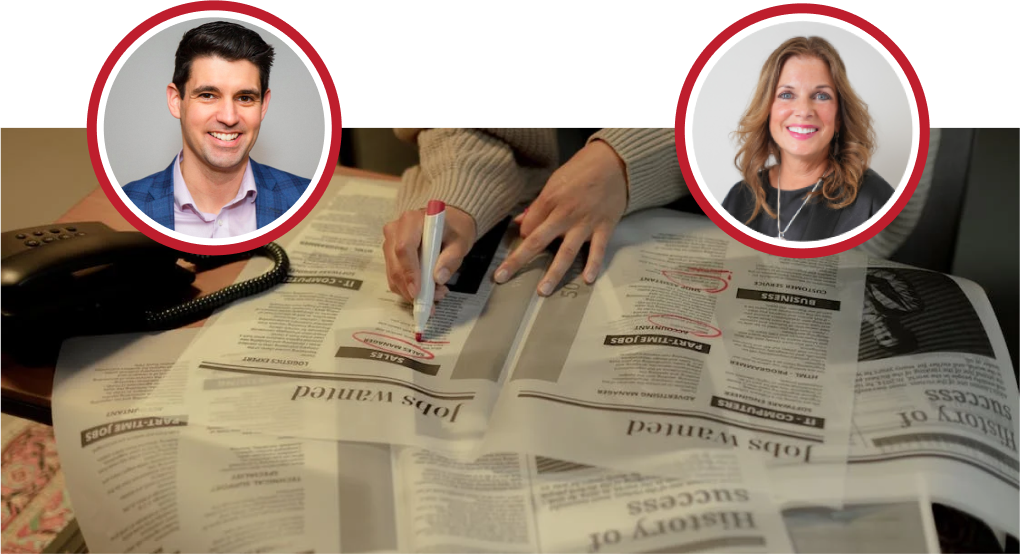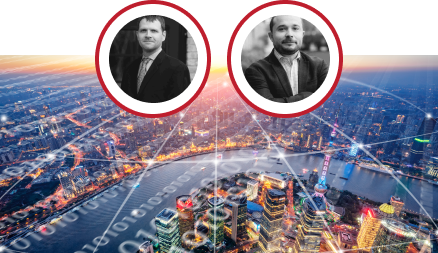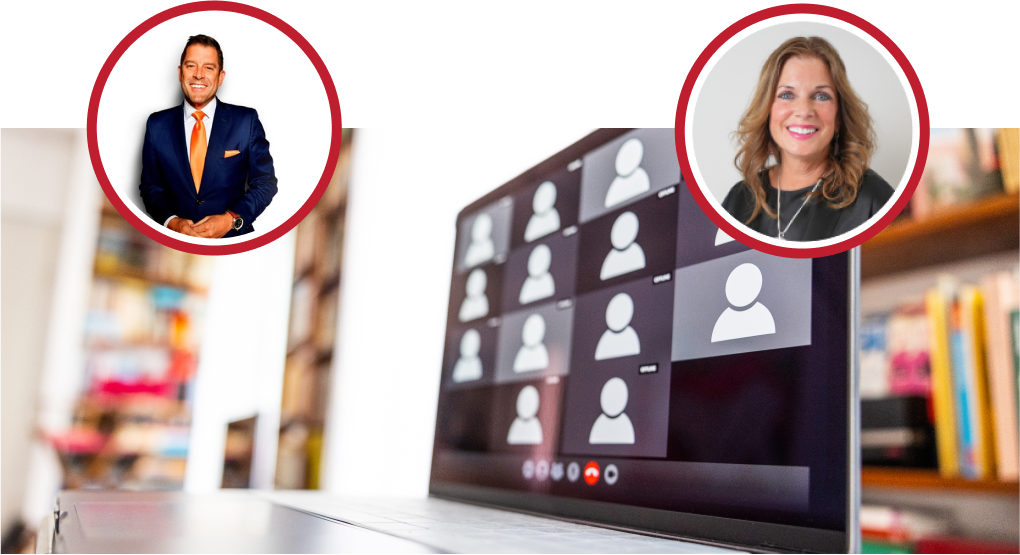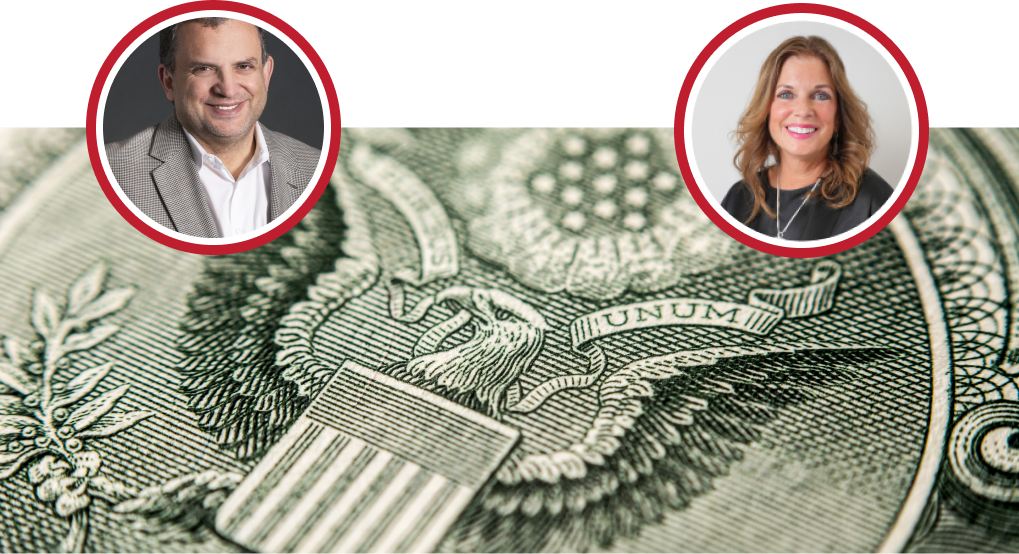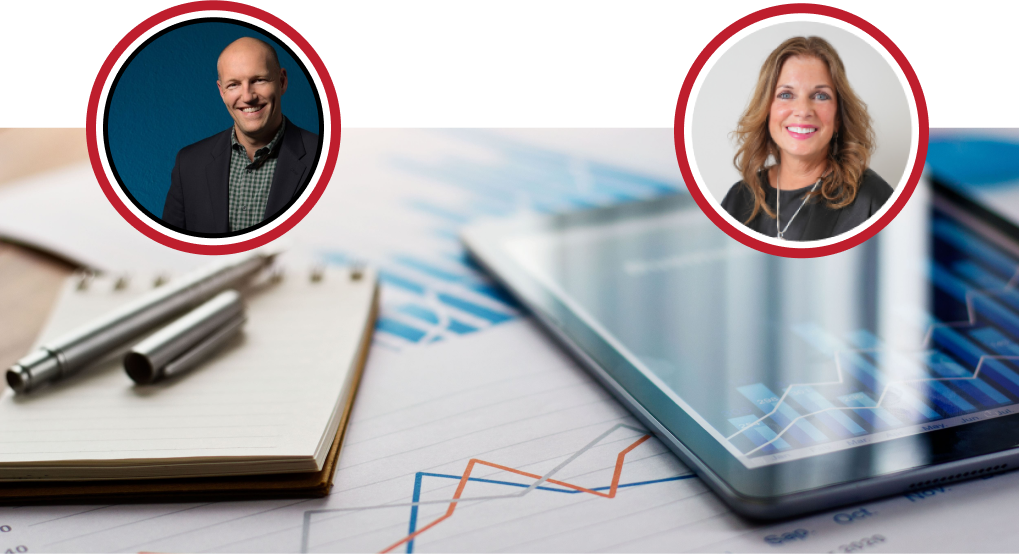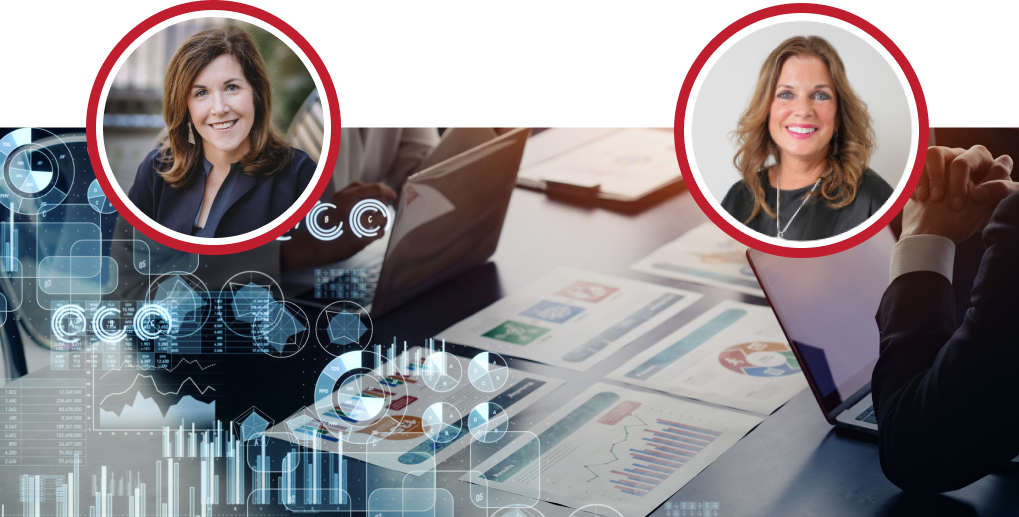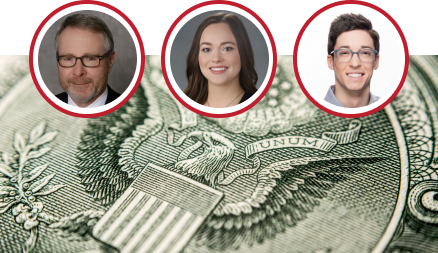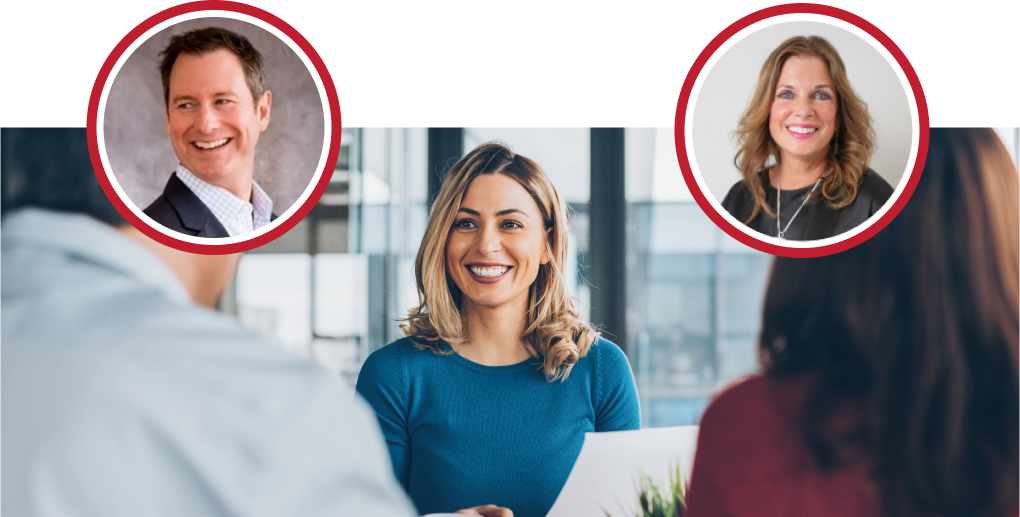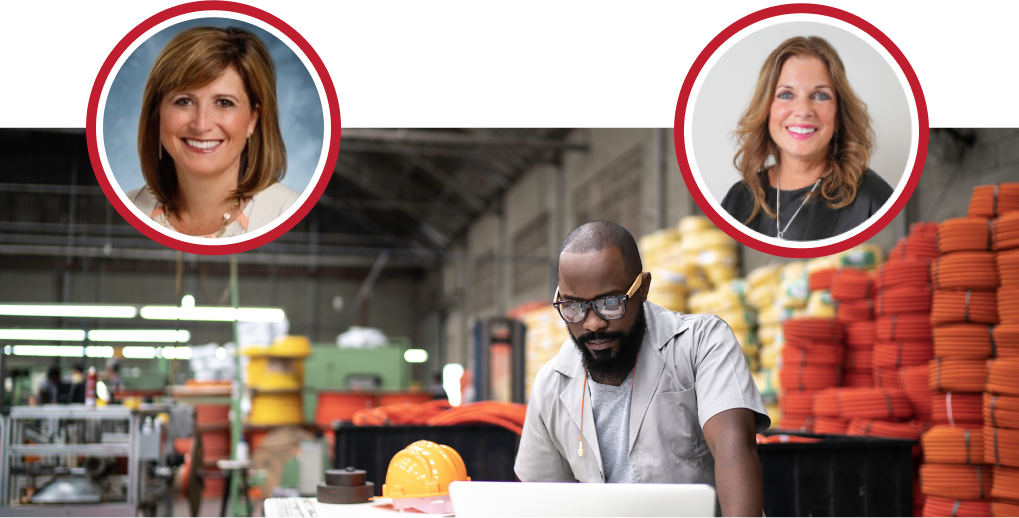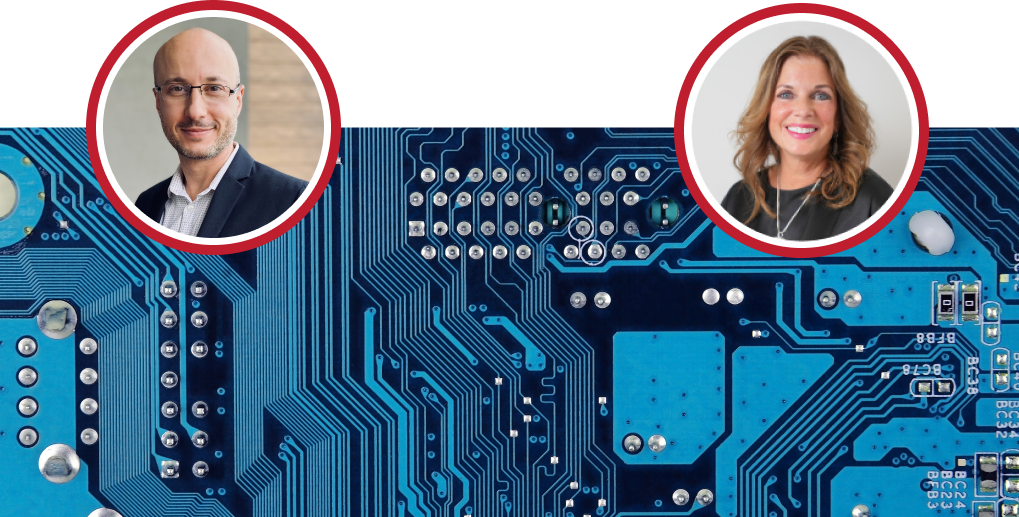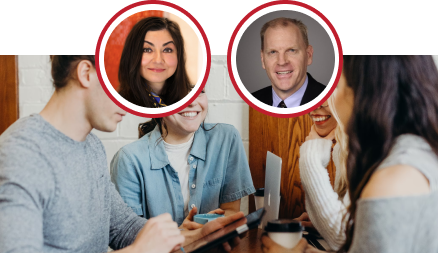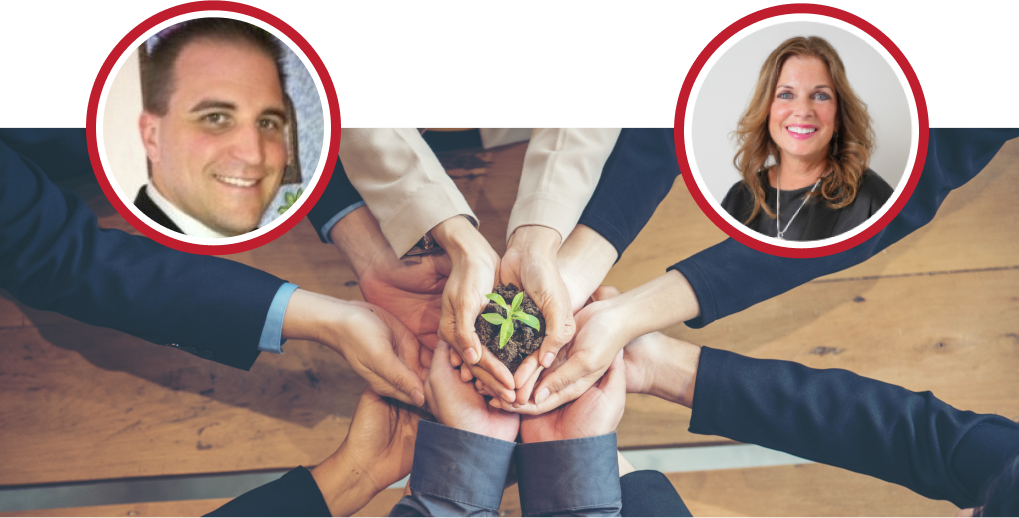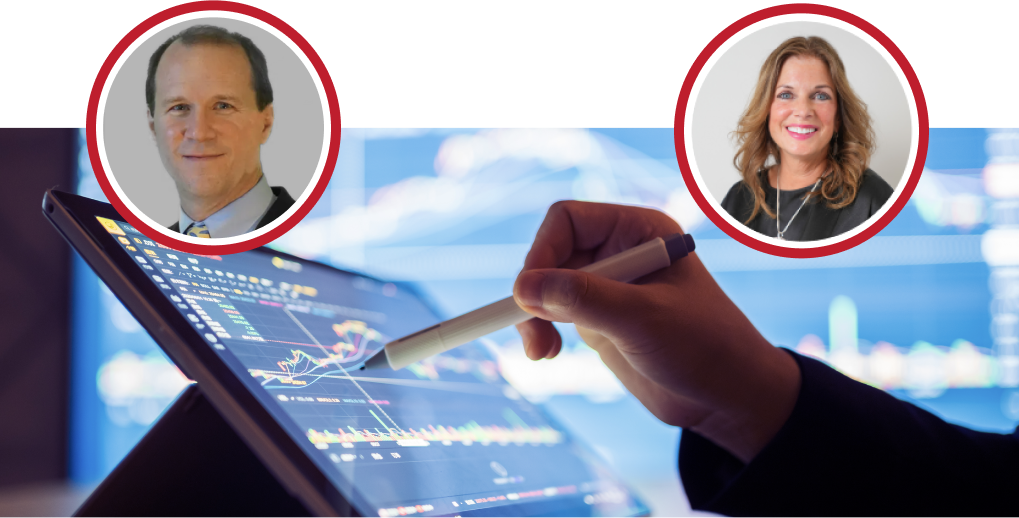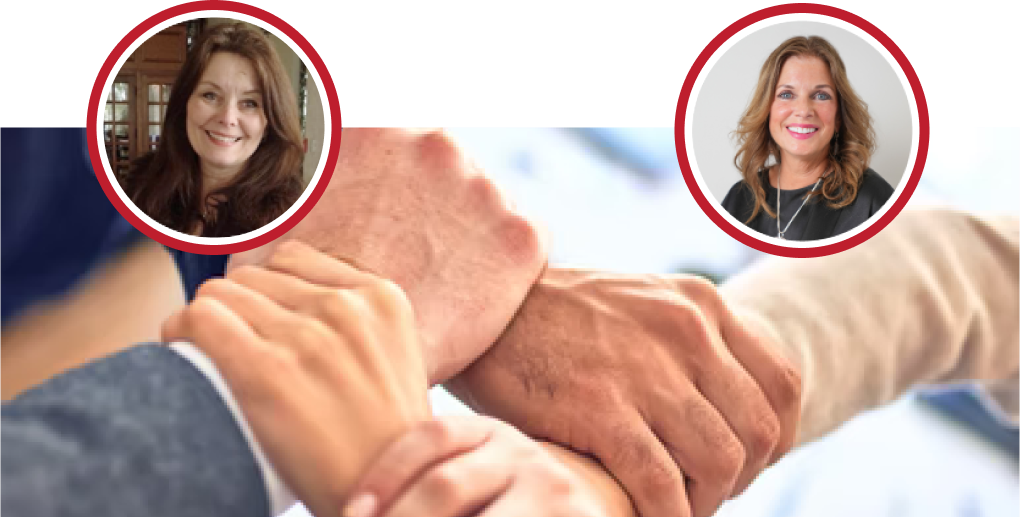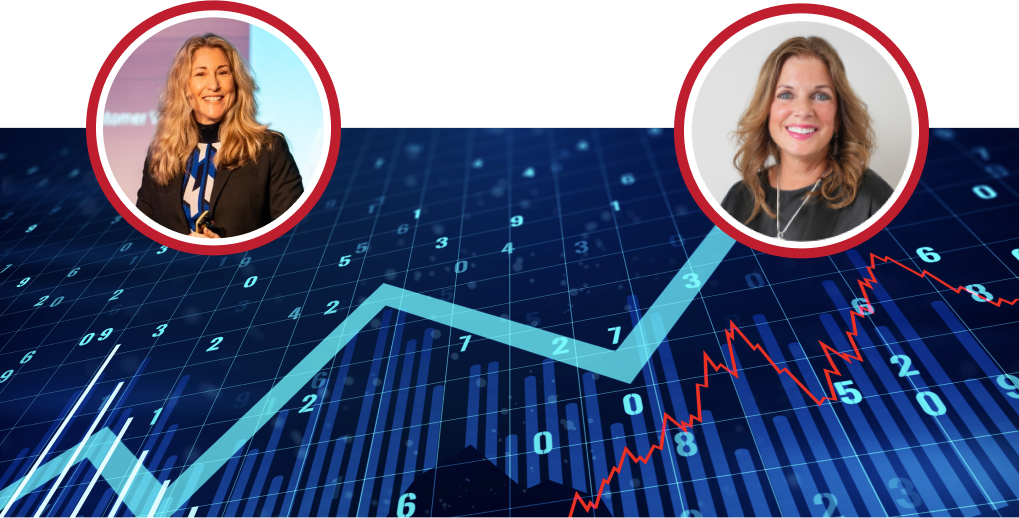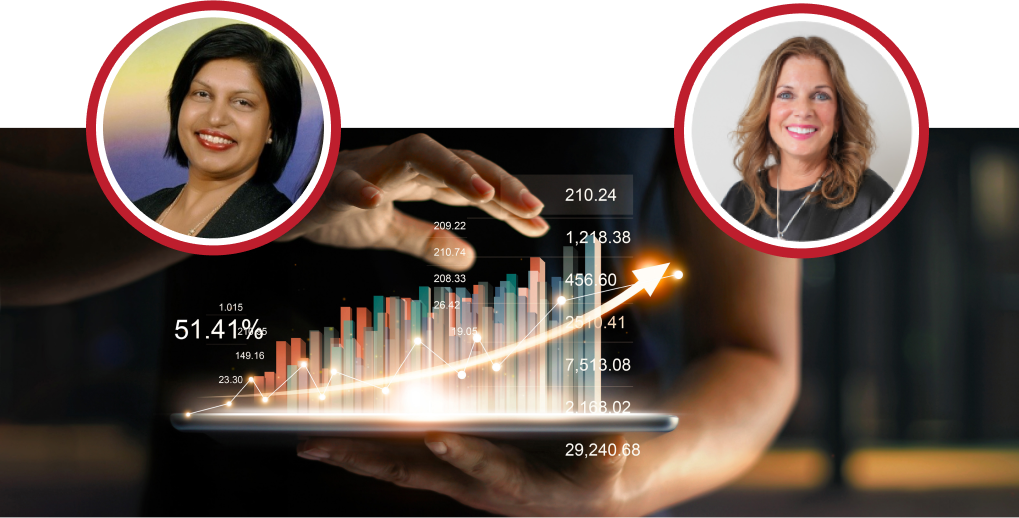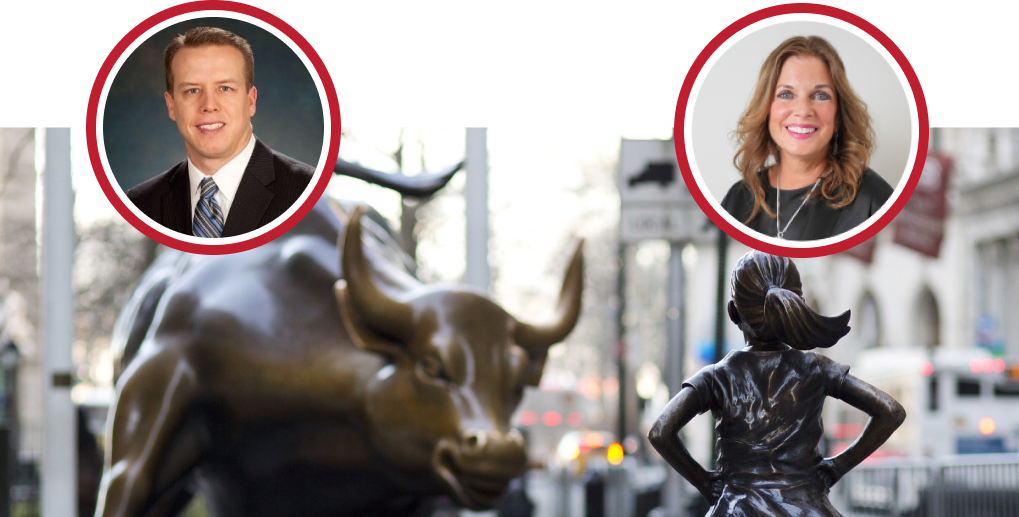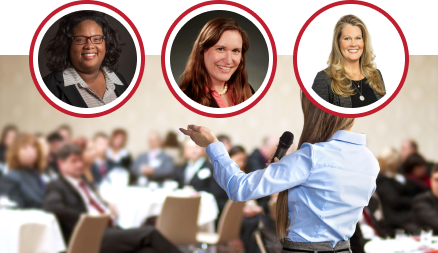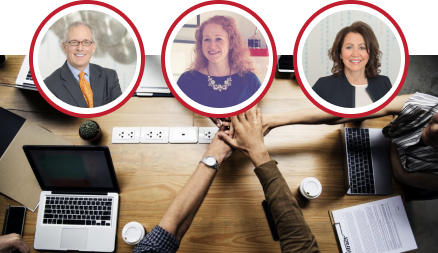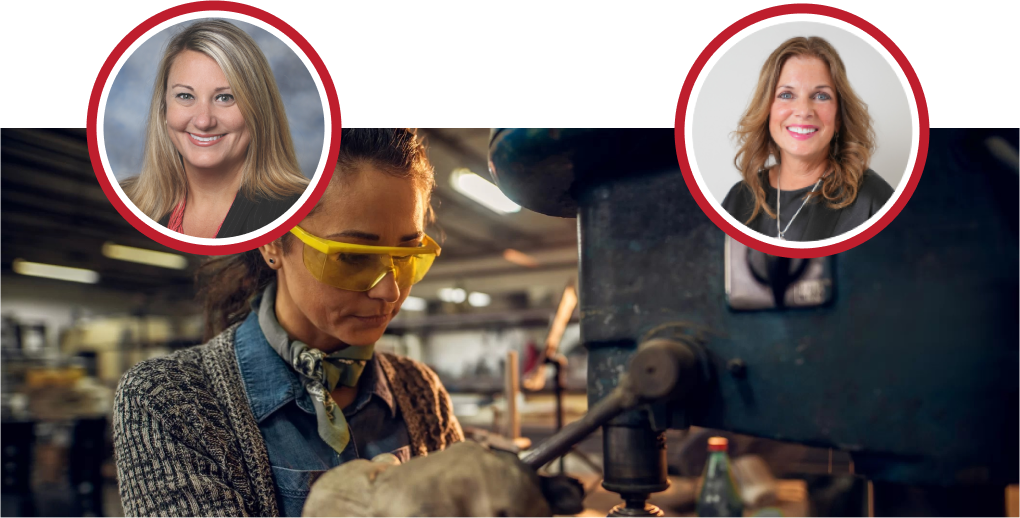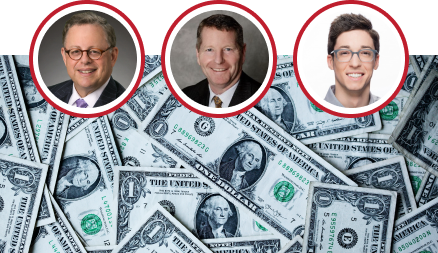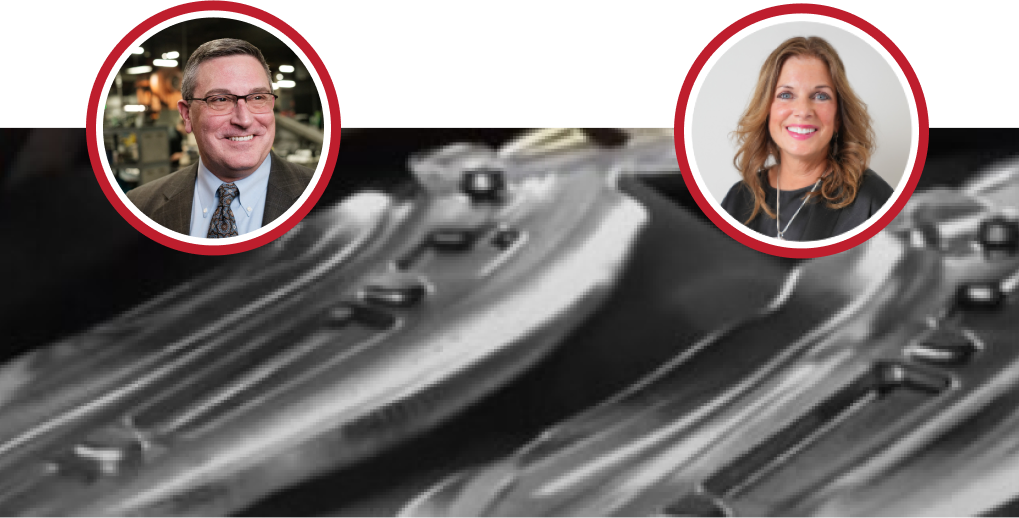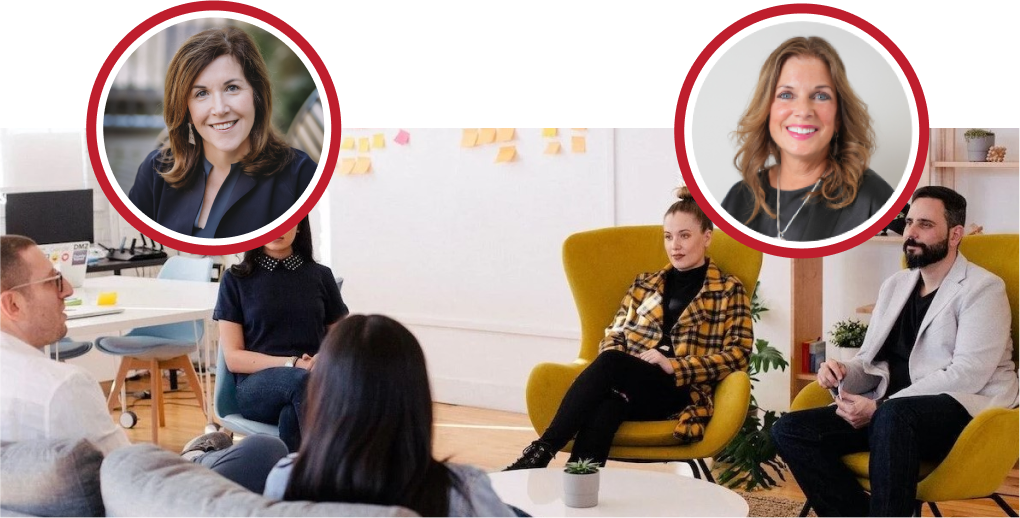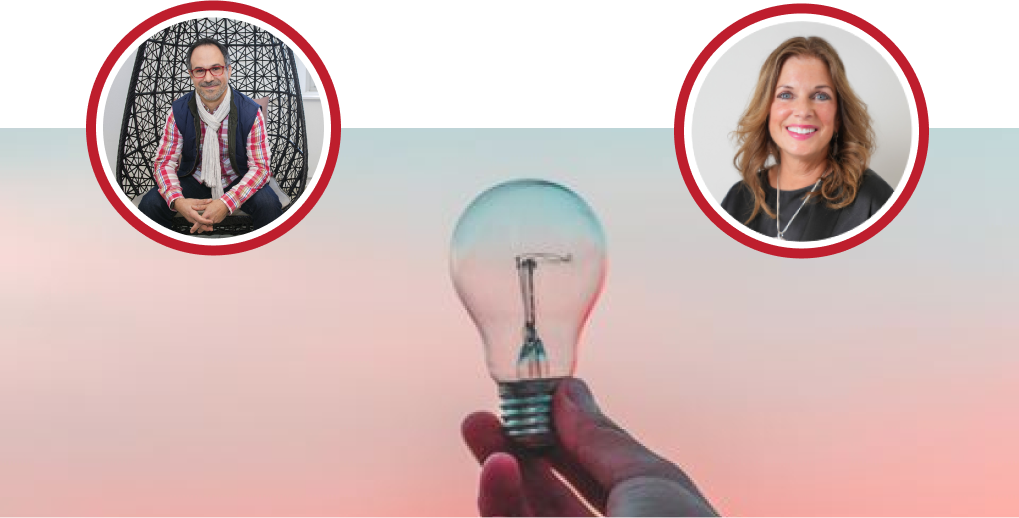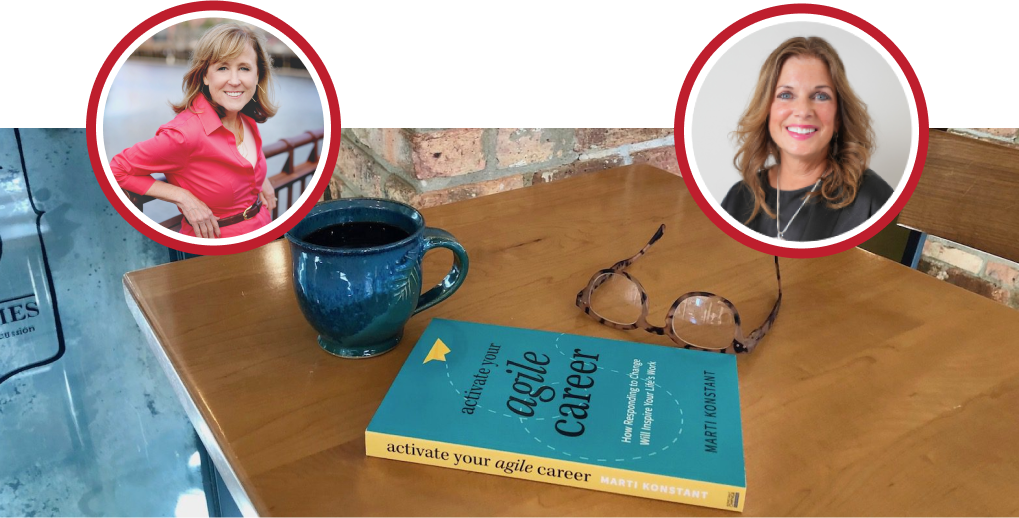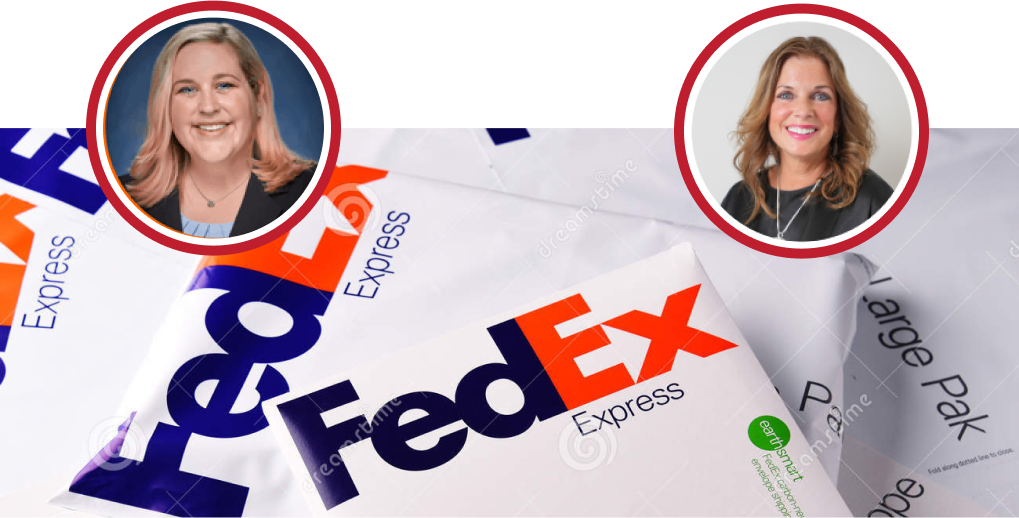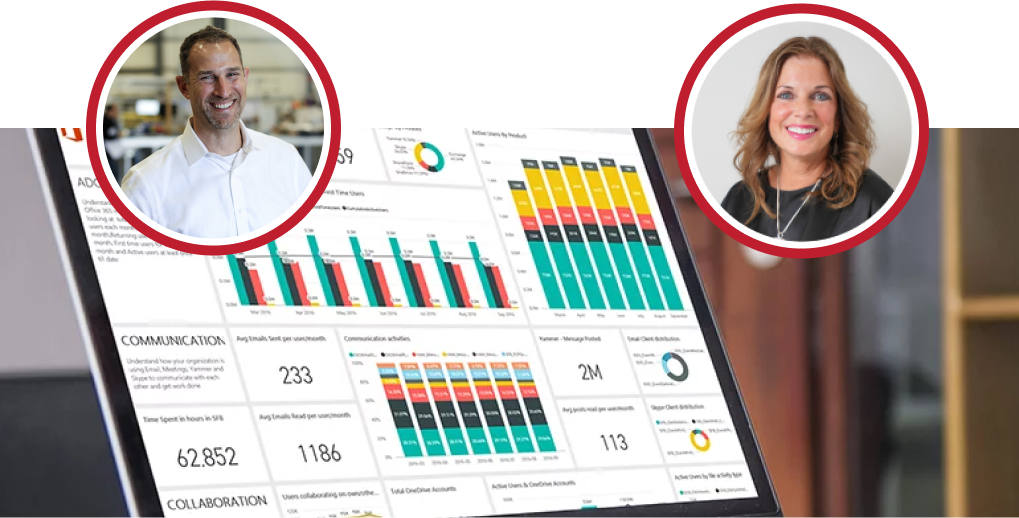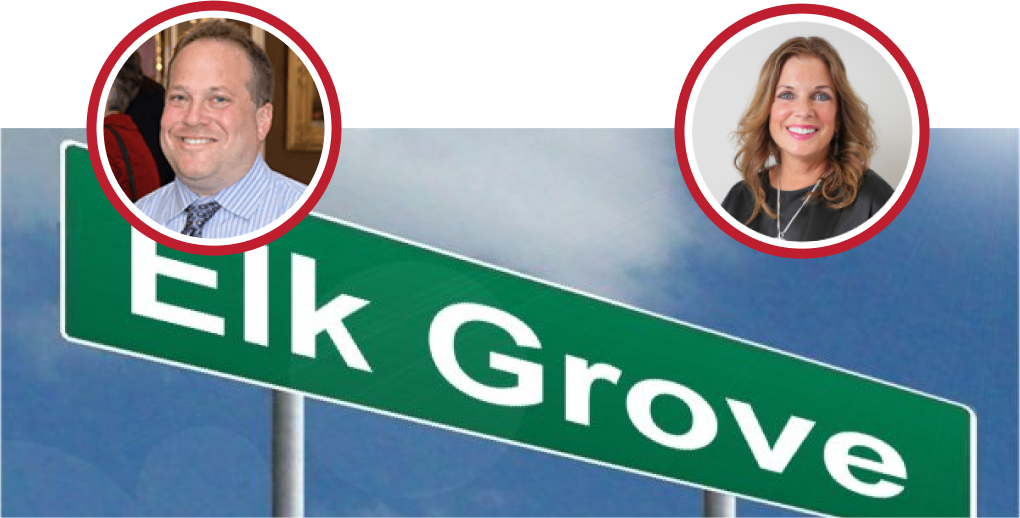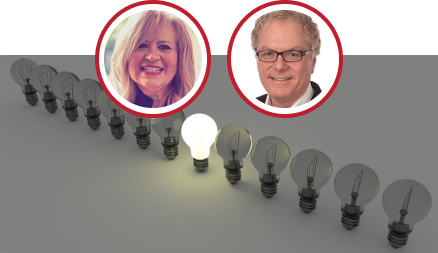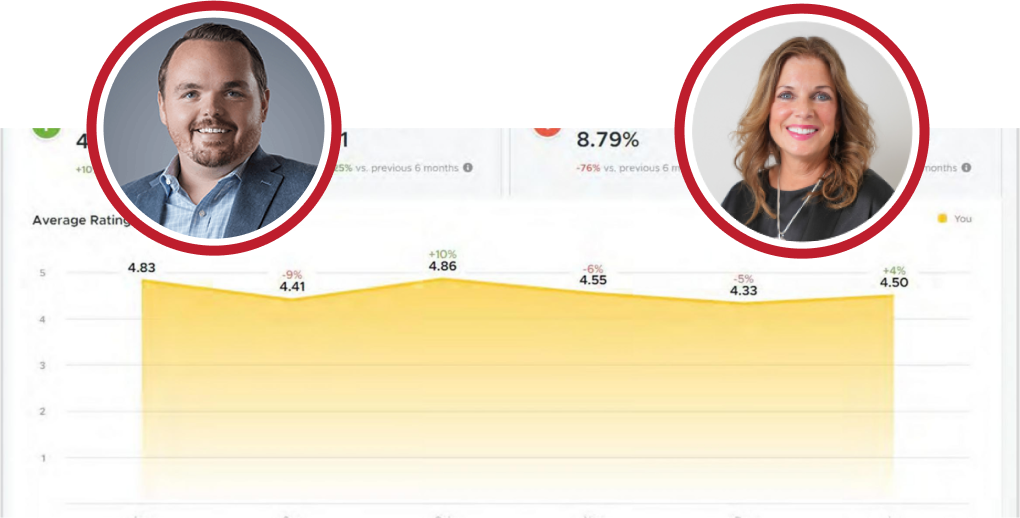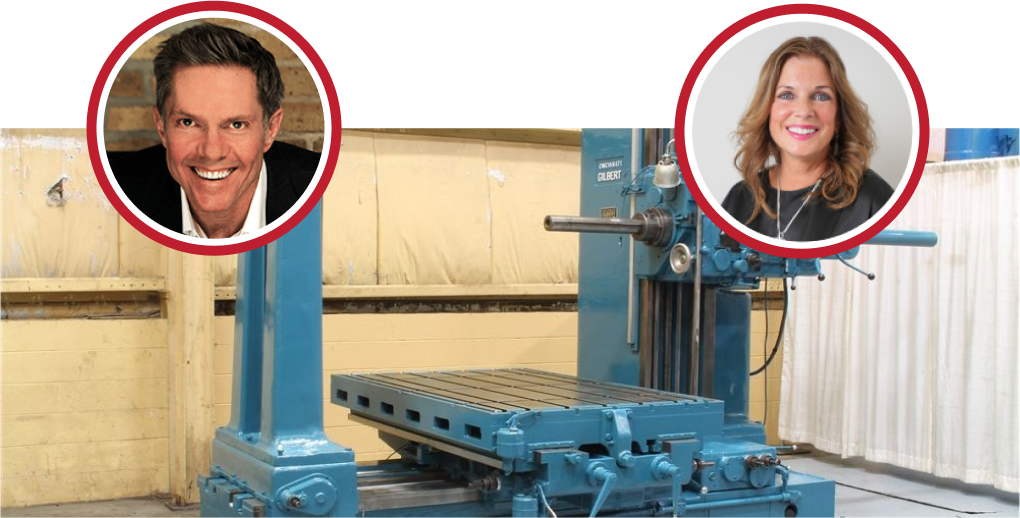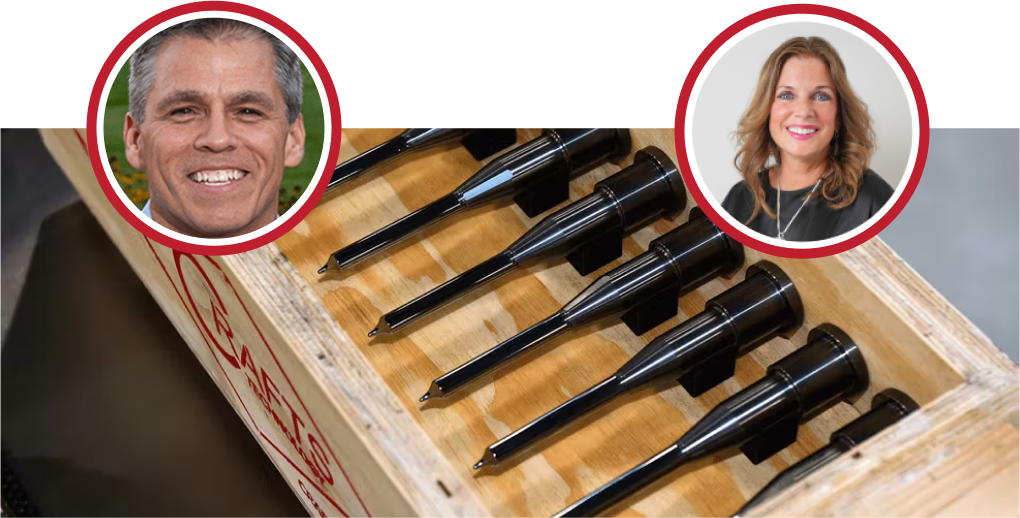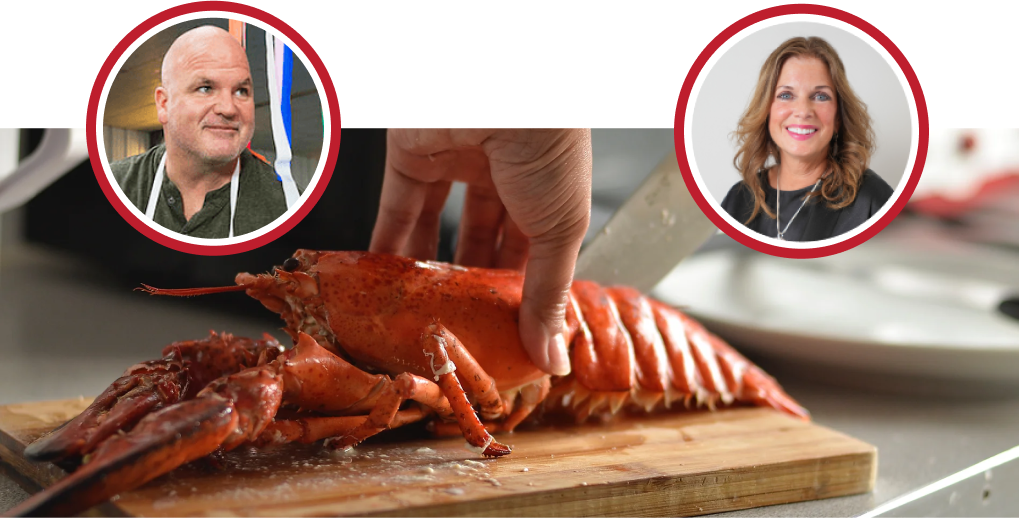Kathy: Well, welcome to business as unusual. This is the live stream where we dig into the pressing issues and emerging trends shaping the business landscape. We’re going to start in just a few minutes, but if you have questions, please feel free to add them to the chat, and I’m going to try and weave them all in during today’s. Really fun and interactive session. So, I am Kathy Steele, and I’m the CEO of Red Caffeine, and I’m your host today. For those of you unfamiliar with red caffeine, we’re a growth consultancy. So we build and execute, grow to market plans for ambitious mid market companies. Our service offering includes A fractional team. That is led by a senior-level marketing leader that enables a business to scale rapidly without having to hire a wide range of full-time staff members to move their growth plan forward. So today, we’re talking about sales with my friend Tom Laray, who is a managing partner at M3 Learning and an incredible sales accelerator. He’s working with business leaders and sales teams. On improving their selling outcome. But sales is a really, really big, needy topic. And so, in our work with red caffeine, we really think about it as a full-scale revenue system because you have to have the right process, tools, technology, and people. But what I love to do about today’s focus is we’re going to be leaning into one of the most critical parts. Of the process, how are sales professionals? Are you positioning yourself? Health is an indispensable partner and really tailors interactions to meet individual customers’ needs. I think everyone who’s sort of in a sales position leading a sales organization or just leading a Business Today realizes how complex selling in the BW market has become. And buyers really have easy access to so many options. They do a lot of research before even having a first conversation with the salesperson. So, how do we turn those tables? How do we prepare to have really meaningful conversations and build strong relationships with prospects? That is a right. Fit. So, as I’ve been calling it, like, no more kissing any frogs. So this is what we’re going to be talking about today. And I’m really thrilled to have Tom with us. Tom, as you know, we’re digging in. Why don’t you start by introducing yourself and maybe sharing something that’s not on your bio?
Tom: So Kathy, first off, I’m just tickled to be part of this conversation. You have been a friend and a business mentor of mine for probably the last 15 years.
Kathy: Yes.
Tom: And so I just love, I love this conversation. I love what you do. I think what’s so important, and you really touched on it, is, boy, those spaces where organizations get sales and marketing and alignment make all the difference in the world. But as you know, we see so many companies. That. There was a lot of this happening, right? Yeah, it’s fascinating. But so I’ve been doing this a long time. I just turned 60, which is like to think about that is crazy for me, but.
Kathy: Congratulations.
Tom: Yeah, thank you. The alternative is not so great, right and so. great
Kathy: Exactly.
Tom: I am reminded, uh, so when I was about 3637 years old, I was Vice President of sales for a vinyl window company. We were a $125 million organization. We had 50 salespeople. I had five regional managers, and I was responsible for the sales, and we were killing it. 3040% growth the year. Great service proposition. We were teed up really well, but we were growing strong. One of my regional managers read a book called Proactive Sales Management by this guy, Skip Miller. So, I hired Skip I. So, you know, sadly, Skip Miller passed away about five months ago. I know he was actually on.
Kathy: Yeah.
Tom: The business is unusual. I think it was about a year ago, right, Kathy and.
Kathy: Yeah, OK, one. You were on it as well. It was one of our most fun episodes. He was epic and truly missed.
Tom: So he wrote, you know, he wrote seven books. But I remember it was 21 years. Well, I remember we hired Skip. He’s going to come in; he’s going to work with my sales management team. So it’s me and my 5 regional managers. Skip comes in, and Skip says, hey everybody, I’m glad to be here. The first question I want to ask you guys, you’ve got all five of you here; who’s your best salesperson? And we said, oh, that’s rich. Kenlock Rich was our number-one salesperson for three years in a row. And there was no question, which was the guy he just hit the numbers all the time. Skip goes great. How do you know Rich is going to hit his goal 12 months from now, and we were like, well, First off, before he even asked that? Question, he said. Why is Rich your best salesperson? And Kathy, you weren’t there. But what do you think we told them? Because Rich sells the most, right? And that’s what your great salespeople do.
Kathy: Yeah.
Tom: Do they sell the most skips? The next question to us was great; I get it. But how do you guys know Rich is going to hit his goal nine months from now? And we were like, well, rich always hits his goal. That’s what Rich does. That’s who he is. He’s an A player. We don’t have to worry about it. Rich and Skip go. I got it. I get it. Let me ask you guys a Question. You’re in this two-day program. We’re going to be talking about sales management skills. We’re going to try to take your organization to the next level. But let me ask you a question. What’s Rich doing right now? What’s he doing today to make sure he hits his goal 12 months from now? At that point, we were nine months in. There were three of us. Months. Into the year and Kathy, we couldn’t answer that question as the lead team; we were spending all of our time. Now. With our C players, the people who really needed help, we weren’t going to teach rich people anything. Rich was already a great salesperson, and I remember. I remember going to the program when we hired Skip. I remember driving there thinking this guy’s going to be so impressed with me as a manager, as a leader of this team that he’s going to want to write a chapter about me in his next book and make sure you spell my name right, you know, and it’s not a capital T, it’s a small T the whole thing, right. And we went to the break for the first time, and I looked at one of my regional managers, Mark Hanson. And I said, Mark, we stink. How did we not? How do we not know? This and what? Skip helped me see. I remember it was, and I’m sure you’ve had these moments in your career where you felt like your mind expanded. That’s what I skip. Brought to me 21 years ago, this space of Ohh, there is a science to this. There is a process. This is not something that just happens, right? Something that we can actually help happen and skip helped us. See. He helped me see.
Kathy: Right
Tom: If I don’t understand what the best salesperson in my organization is doing on a daily basis and how they’re achieving success, I can’t hire more rich people. I can’t coach my C players to be like rich people. And the reality is I might lose rich people because I had just removed an obstacle or two from rich people.
Kathy: Right.
Tom: He might grow his sales another 30 or 40%, and he’s watching us spend our time with our nonperformers. That was a really cool time, and so I’ve been. I’ve been a coach and a consultant. We worked with Skip for about another 10 years. We grew from a $125 million company to a $500 million company. We got purchased by Fortune Brands, and then for the last 12 years, I’ve been a consultant of M threes. Philosophy. And with skips passing, we kind of feel like we’re 28 years old. Old startup. We’re trying to make sure you know the best way, I think, to honor my friend and mentor is to carry and teach generations of new sellers and new organizations the philosophies that made a difference. Me. And that’s what I’ve been doing for the last 10 years and I just love this conversation. I love coaching and training salespeople and so. So thank you for having me. That’s a long answer to your question, but.
Kathy: Yeah, but I mean, I really appreciate you sharing the leadership transition. It is really challenging for any organization to undergo any kind of leadership shift, so I just give you a lot of credit for moving the business forward. I’m super grateful that Skip’s training and thinking are going to live on beyond Skip, so that’s that’s the best.
Tom: Yeah. And it’s, and it takes, and you know, as sad as it is, it’s also an exciting time. It’s time for us to figure it out. How we can take some of the, you know, take some of the tested and tried philosophies, but then also add some of the new things that are happening in thought process and and. Tense, and it’s an exciting time in terms of communication and human psychology. This is all kind of coming into this conversation. And so let’s talk about a lot of it today, so.
Kathy: Yeah, no. I think you know, as we were preparing for today, we talked about doing some. Some things we talked about, like talking about first dates and wedding dresses, so let’s jump in. Let’s think, you know, maybe what would be important is to kind of set the table around what is. What is in the mind of a buyer? Like where? Where are we? Where? Are they coming from before we can even decide where we’re going to be coming from?
Tom: I love that. I love that. So this is the first time we almost start every single program we have. I was doing a program probably about five or six years ago with the folks at Carrier and HVAC equipment company, and their VP of Sales, Bill Walton, used this slide to teach his team. And I love this slide so much and so. Kathy, I want you to think about when we are new salespeople. We joined an organization. We’ve got very little solution expertise and we have a little, very little relationship with our customers. These people are order-takers now. So, Kathy, when? When I ask you to say what an order taker is, what are some examples of order takers?
Kathy: Well, I mean, well, I haven’t been to a fast food place in a while, but I have been a lot of times. That’s like. Quick serve comes to mind in that experience.
Tom: They take your order. You tell them what you need, and they take your order. Now we need order takers. So, order takers are very important. But the interesting thing is that when we’re an order taker, the only thing we can do is just react to what the customer wants right then we learn a little bit more. And we become a product seller. We learn a little bit more and we become a solution provider. Now, Kathy, if I had to ask you the difference between a solution provider and an order taker, what would you say? How do I function differently as a solution provider than I would if I was just an order?
Kathy: Yeah. Well, I think then you’re providing optionality, so you’re helping them understand what is important to them and then maybe your service product, hamburger, you know their needs.
Tom: Let’s say I’m an order taker at Starbucks. The barista and I get your coffee. But now, all of a sudden, I’m a solution provider, and I say, hey, you look a little hungry, too. Maybe we’ve got some great baked goods. We’ve got all of a sudden; I start offering you different choices because I’m starting to understand your needs a little differently. But I also know.
Kathy: Right.
Tom: The way that I can support my organization. Now we learn a little bit more and we then get to this. We add the word consultant to it. So now we are seen as a solution consultant. Kathy, the minute we tack on the word consultant, what happens? What happens with our relationship with the client?
Kathy: Yeah, I mean, I think they know they can lean on you because you’ve got that superior knowledge base. You’ll help them consult through their challenges or business issues.
Tom: And wouldn’t you agree that a lot of times consultants know as much about our business as? We are good consultants and even know a lot about the industry; they actually are guiding us into choices we can take out of those four options. Right now, we’re only up to a solution consultant. Which person might say you know what I don’t know for the best solution for you, you might want to go with my competitor. Who would say? That.
Kathy: I would say it has to be on the consultant side or be on no.
Tom: I would be the only person who would probably say that, and you know, I’ll say this to salespeople, and I’ll go, well, that’s kind of crazy. And salespeople, you’re right about that. Why would you say that? And then the question I ask is, yeah, why would you say that?
Kathy: Ohh.
Tom: Why would I actually recommend a client go to a competitor, and the word that keeps popping up is trust? Once I’ve once you trust me, I’m not selling you something. I’m actually providing a solution. I’m helping guide you to the appropriate answer for you. The client? That’s how I think. Like a consultant. Now, the pinnacle of this conversation is how do I become a strategic partner now the minute I add the word, the minute we say strategic partner Kathy, how does a strategic partner operate differently than any of these other people?
Kathy: I mean, the way I think about it from our context is usually they’ve just got a lot more experience. So they’re really able to see the vision and help articulate or architect a solution based on a little bit broader perspective than just the one little, you know.
Tom: That’s great. The scene in Hamilton the musical where Aaron Burr sees conversations that are happening in a room where the door is closed, and he goes. How do I get in that room? I want to be in. The room where. It happens that question I asked salespeople if. Your customer is making decisions about 2026 & 2027. They’re thinking they’re thinking about their growth. They’re thinking about expanding; they’re thinking about different markets that they need to go into. Out of all of these salespeople, who’s the only person who’s going to be invited into that room that’s having a where where your client is having a. A conversation about their future. Think you’d agree? The only person who’s going to be in there is the strategic partner, right? Absolutely. And so you made a great comment. Too many times, we think that the only way we can become a strategic partner is through experience. Now the challenge that I would say to a salesperson is you just join the organization. You’ve only been here for two or three months. I can’t wait. I can’t. Wait 15 years for you to become a strategic partner. And here’s what the conversation we’re having with people is: how do I operate like a strategic partner, even if I’m only an order taker? How do I operate like a strategic partner in space? I’m a new employee, or I’m just learning this business, and our piece is we think you can do that because you could ask questions you can operate differently, which then answers your question. We have to think. How the buyer is thinking and so skip used to say two things that were skipped isms that we use all the time. Most people want to buy. They just don’t want to be sold.
Kathy: Yeah.
Tom: The second thing is that people don’t want to be educated; they want to be validated. Strategic partners are all about helping the client validate the choices. Understand. Does that make sense?
Kathy: Yeah. And I really felt like that gave me even more pause when we were prepping because I hadn’t quite thought about the validation. Be really important to you know, not feel like you’re always bringing somebody along, but you’re affirming that you know this is an issue. It and you’re able to help say, like we may have the option. And be able to solve it for you. You may need somebody else, but let’s learn more; I guess that is the way.
Tom: I and validation too many times. We think about validation as just being, oh, me agreeing with somebody. That’s not necessarily what good validation is. I mean it, it’s definitely that space of taking somebody, you know, moving them when they’re ready, but also making them aware, which is what great strategic partners do. Hey, are you aware this is what’s happening in the industry? Are you aware that an AI is doing X that this is happening? These are happening. That’s what we need to be doing.
Kathy: Right.
Tom: We need really powerful strategic partners in today’s world. We can’t just be people who push our product because we’re not going to be in the right conversation. Now, we might still get transactions and some sales. We’re probably just not going to become long-term partners. With those clients, does that make sense?
Kathy: Oh, absolutely. I mean, I think. You’re spot on.
Tom: And so that I think you asked the, the, the one conversation I love to have is we got to think about it like first. It’s test drives and wedding dresses. And so just if we can show the next slide. I love this slide because it really shows what we see happening in today’s sales environment. First, we’ve got to think about the buyer’s journey and the stages. They go through their buying process, and so do most people if you think about the first stage. I’ve got questions. I’m initially interested. I don’t know what I don’t know, and I’m starting. I need to accumulate answers. I need to. I need to figure things out. Then I want to be educated. Then, there’s this space of actual validation. So I’ve learned something. Now, I want to validate what I’ve learned. Then, I’m going to justify what I’ve learned, and then I’ll make a decision. But here’s what we see. We see three things that are happening today. We call it the start, the split, and the Skip. The 1st is the start. You mentioned something, Kathy, that’s going on. Clients are coming to us so much more educated than they’ve ever been. And so I’m sure some of the conversations that happen at Red Caffeine, customers pick up, the phone sends an e-mail and says, hey, I’ve done a bunch of research. Looks like you guys can help us. I’d love to know. How you guys are better or different than here’s what I’m doing today. How are you better or different from this solution? And they push us into an educational conversation. And so as salespeople. The customer pushes us to education, and we go great. I can tell you all about how awesome I am. So our first date is all about us instead of the other person, right? Kathy, if I had to ask you, what are the objectives of a first date? What are they? What are the two objectives of a first date? If we were having a first date, you know, it’s been a long time. Time since I had a first date. I know the same thing as you, right?
Kathy: Yes, it’s been a long time, but you know, I think about it. Yeah, I do feel like there needs to be some chemistry. If I were thinking about dating, I’d want to feel like we have some matched values, we share some commonality, and that would be what I would want in a good person.
Tom: So, really, those two objectives I mean first, the first one of the objectives. Let’s agree that there is never a first date objective of I want to meet you, and we’re going to get married. Tomorrow, would we? Agree that that is not an objective, but the objective would be.
Kathy: I do like it.
Tom: Maybe it’s on a reality TV show, but that’s one of the objectives. It would be. I want to see if a second date is made. It makes sense for both of us. Does it make sense for you? Are you somebody that I’d like to have a second date with, and am I somebody that you’d like to go on a second date with? The only way to do that is I have to learn as much as possible. I can talk about you. Not about how great I am. Here’s the problem, though. In business, if you were to take a look at the slide decks of most organizations, you see this all the time and the work. You do those. 1st 10 slides are hey, here’s how long we’ve been in business. And here’s who here’s our executive team. Here’s our map slide. There’s always a map slide. Right, that shows.
Kathy: Yes.
Tom: So we have to shift that. We’ve got to get into true discovery conversations, and then these next pieces, we see a split where two languages are spoken. We’ll talk more about that and then this. Most organizations jump over the transfer of ownership, and we’ll touch on that, too. So I think this slide really just reinforces 1 the stages but also the three important pieces. First, dates are all about discovery. Test drives are all about validation, and then we’ll get into the three languages, so that’s I. Unless you’ve got you have any other questions about this slide? I think it’s just.
Kathy: Well, I don’t know if this is related to the slides per se, but I think we always are; whether we’re going on a first date or we’re going on a first meeting, we need to prepare some things. So, what are some of the things that you do to prepare for that first discovery conversation?
Tom: Well, again, it’s all about the space of my objective. I need to learn as much as I can about the other person, and so our recommendation is you do a little bit of research. We call it three by three research. I’m going to look at three things. I’m going to look at Google. I’m going to Google you. I’m going to Google your company. I’m going to see if you have talked about or posted about things that are important to the objectives you’re trying to fix and solve. I’m going to take a look at your website to see if you’ve posted things like that, and then the third thing I’m going to look at is LinkedIn, and I’m going to see because. LinkedIn has become this business. It’s like a repository of what’s important to many people, so many people will actually say what’s important to them on LinkedIn. And the second thing is you and I might have a mutual rapport. We might have people that we know. And so all of a sudden. That space of me becoming known, liked and trusted because I think we’d agree the way to become a strategic partner is to establish a level of trust. Trust, and if we can establish trust through the people we know and the things we know about other people, all of a sudden, that creates a powerful place. So. I know a lot of salespeople who will go, oh, I want them. I want to be spontaneous. I want to pick up the phone and just learn it. And you’re actually putting yourself at a disservice. And I think the clients if you go on a call and you actually tell the person that you didn’t do research, you didn’t take a look at their website. You didn’t take a look at them. And I actually would look at you in a diminished state. Like what? Really, you didn’t do any of that work. Why did I spend all the time to make my LinkedIn profile look so cool? Right.
Kathy: Well, I think too, you know, even the fact that they’ve likely done some diligence on you, they’ve done some research on you. They’ve looked at your website, or you wouldn’t be even in the equation, or they’ve seen.
Tom: Yeah.
Kathy: Your business in some marketing or some other brand awareness tool. So, I absolutely agree. We’re actually using AI to do a little.
Tom: Oh, I love it.
Kathy: More. Search speeds things up. You can sift through things and go deeper in a certain area, too, because it collects a lot of different resources. So it makes Google search even more powerful.
Tom: So then you do some research which should point you to issues, problems, challenges. Things would hammer with me all the time. Anytime we were having a first conversation with somebody; skip would say what’s the problem and What’s the size of that problem? And if I couldn’t articulate if I couldn’t say that I had an understanding of the problem or what. The size of that problem was then would say, well, you’re just pushing product, then you’re just pushing sales training. Why don’t you understand where they need to go? And so in our challenges, where are you today, a scale of one to 10, how comfortable are you where you’re at? Did you hit your goals? Are you not hitting your goals? Ohh. We missed them by 20%. OK, so you’re A2 or A4. Where do you need to be? Oh, we’ve got to be here. Great.
Kathy: Right.
Tom: The work we do. Do is actually help you close that. Gap. And so once you want to find out the problem and the size of the problem our biggest recommendation is in discovery. You ask three questions; you ask cause questions. Outcome questions and decision making questions, we call it COD. And so, what caused you to look at our website? What caused you to pick up the phone? What caused you to take this call? What’s happening that you guys need to fix or solve? What’s the problem, and what’s the size of that problem? Tell me more about that. Where are you on a scale of one to 10? Where do you need to be? And how quickly do you need to get there? So one, we have to understand the cause before we let me tell you how late we are. The second thing is outcomes and its positive outcomes and negative outcomes. So, where do you want to be? And what are the things that you got? To make sure. Definitely doesn’t happen. We are working. We’re working with a software company, Logistics, a software company in the logistics space, and one of the things that happen is they find out when they are when they get higher up in the organization. They start understanding the critical risks that are inherent if they don’t meet certain criteria based on government regulations, and one of those issues could cost them millions of dollars. So the risk is really. They’re an organization that does that. They minimize that risk; they make that risk like this. Now, they’re more expensive because of that. And so certain people in the organization are going to want you to talk about the nickels instead of the $100 bills that you save.
Kathy: That’s right. Oh yeah. And. And I think that kind of goes back to a couple of things that I was thinking about. First of all, you know you talked a little bit about where somebody has come to you. With the need, I mean there are times where we’re getting in front of prospective customers, and they don’t have maybe quite as pressing of a need or their. In more of that earlier research phase, is there a way to unpack that in how you’re prepping for this type of Meeting?
Tom: Yeah, I think that’s a great question. And so the same thing in terms of the research, you know your knowledge of the industry, you being a strategic partner, you think like a consultant. In that space of listening, we work with lots of people at your title. We work with lots of folks in your industry. They’re telling us that these are the top two or three issues that they’re running up against. How are you guys doing with those? How are you addressing those? What are you guys doing? What’s working? And what isn’t working? Tell me a little bit about those. Are these priorities, or are there other things that are even bigger priorities for you that I haven’t? Even brought up. If I can get into that conversation, then I can say, OK, well, you know, there may or may not be a place where I can help you, but I don’t want to tell you about me and my company before I understand if this even makes sense, if it even makes sense for me to have an education conversation, does that make sense?
Kathy: Yeah, it does make sense, and I think about, like, I know a lot of the things that we are recommending are around, first of all, just really understanding who your ideal customer is and is. You know, having clarity around that for the sales team, so that when you’re doing some. Of that upfront. Research it’s not always available. Some of the financial information, but you can get a fairly decent idea around company size and employee head; those kinds of things are fairly readily available online, I think. You know, it becomes more complex to understand, you know, unless there’s a clear answer. The difference in titles like decision-makers is if you know if you’re meeting with a person, are they going to be able to write the chat, you know. So like I think those are the things that come to mind too is how you may have.
Tom: That’s the third piece. That’s the D is the third piece and. And so the biggest recommendation we make is, I think most salespeople will ask a question along the lines of, are you the decision maker? Who’s the decision maker? Our belief is in, especially in today’s world. You want to ask, what’s the decision-making process in your organization? Who becomes this really? Oh, I’m. I’m going to make the decision. It becomes almost this territorial question. But what’s the process in this organization? How do you guys make decisions? Here, what are the teams that are involved? How does that work? We work with some organizations that actually will try to find out how involved their legal department is so that they could actually maybe help Marshall this through. Whatever has to happen in the legals again, that’s how you think. Like a strategic partner, right?
Kathy: Yeah, absolutely. We were just talking about that internally because it depends on the size of the organization. I mean, we’ve done a lot of work with Amazon Web Services, and we always knew. We had to get the legal piece started because they had a very short timetable for getting this work into the market, and we were always delayed if we didn’t get in front of the legal team.
Tom: That’s why I love a decision-making process question in discovery. Let’s not wait until we’re in on the proposal. Let’s actually have a conversation about how you and your team make the decisions around here, who’s involved in that, and what the things are. I just want to know that now so I can help you actually guide this through your organization.
Kathy: Yeah. So.
Tom: And you know what you’ll hear, and you’ll hear the spaces where? Maybe that person will guide you and tell you where you might be able to help them.
Kathy: You know, I really love that. I remember that from our prep session, and honestly, it’s so funny that it just happened to us this week. So, you know, I don’t know if I’ve clearly delved into validation, so I’d love you to tell me a little bit more about that part.
Tom: Yeah, right.
Kathy: Of the process.
Tom: So. Typically, the best space to validate is later in the process, right? So like, I’d like for you to imagine. Kathy. When have you bought a vehicle in the last four or five?
Kathy: Years. But I’m thinking about it.
Tom: How successful would I be as a salesperson if I said, hey, let’s take a test drive? And I put you in the passenger seat, and I said, Ohh, you’re going to wait. Do you feel how this baby handles it? And I showed you how the car makes the turns and how successful I would be if I was the one driving the car and you were the 1 sitting in the passenger seat.
Kathy: Yeah, I mean, yes.
Tom: So where does the client sit in a test drive?
Kathy: In the driver’s seat.
Tom: Of course. Why is that?
Kathy: You want them to feel the experience of working with you, your solution, your technology, whatever you want them to be able to see, and to see how your solution or your product might make them.
Tom: Our challenge to the sales organization, if you remember that skip, what happens we see.
Kathy: Quiet.
Tom: Lots of organizations skip, they educate, they talk. So if the way I educate you, if I’m driving the car, I’m educating you. If you’re driving the car, you’re validating the decisions that you’re making, right? And the question we asked organizations is what are your validation steps? What are the things you do actually to allow the client to get it? And if you can see this behind me, skip used to say you want to help the client go from me. Get it to ohh. I get it. So I, you know, a great example is we were working with a. CNC manufacturer they manufacture $1,000,000 CNC machines. Well, you can’t take a test drive on a $1,000,000 CNC machine if you’re a manufacturing facility. But what you can do is you can see one in action. So this salesperson was extremely successful, and what he would do is he would go, oh Cathy. You guys are looking at the XP 507. I have a client that has that product. They don’t. I don’t do the same thing you do, but I tell you what. I’ll pick you and your team. We’ll drive over there. They’re about an hour away. We’ll drive over there, and I’ll show you an action so you can see the machine in action. And my client has agreed to have you there, and he’ll walk. You through it. So. The salesperson would drive. He would pick him up. They would talk the whole way there, and then he would introduce the client. He’d say I’d like you to meet Jim. Jim met Kathy, and then he had one job to do; the job was just to keep his mouth shut. Shut him. Would sell the client to rivals. The machine was fantastic. That’s a validation exercise. Does that make sense? Right.
Kathy: Yes, absolutely. I mean, I think it’s honestly so brilliant, especially in those types of applications where you were stepping away, and you’re using peer influence to help you know. In that kind of endorsement, it’s like you can say, call my testimonial or what have you, but it’s way more validating to see it.
Tom: Peer peer endorsements, one of the really powerful validations of a future vision question, or is also one like Kathy, you’ve told me that you need your team to achieve this objective. I’d love for you to think. Let’s say we go. Let’s go out 12 months into the future. Actually, let’s go. It’s January 1st, 2025. You’ve just achieved your goal last year and you’ve achieved it at a pretty high level. Let’s say you were 5% over goal last year. How’s the organization operating differently? How are they functioning differently? What are the things that you’re doing differently eight months from now than you are today? Talk me through what that is. Look like.
Kathy: Well, I think exactly.
Tom: That’s a validation exercise, right?
Kathy: Yeah, you’re really helping them think visionary about what we do that a. Lot like let’s. Write your future press release on how we’re together. It could be stolen from Amazon, but it’s something they do a lot in their process. But yeah, I think making people see the shared vision and then really hearing them articulate what success looks like is incredible.
Tom: And then the last thing I would say is this thing, let’s call this the customer pen. Instead of me writing it down and telling you what those numbers are, I give you the pen. I give you the spreadsheet, and I go, let’s put your numbers on this sheet. Let’s put your numbers here. What would that look like? Does that make sense? So, I actually create exercises that you can do. Now, here’s what’s great. I can do that in discovery. I can do that in education. I can do that throughout the buyer’s journey, and I can always be validated.
Kathy: Yeah, we just got a question, and I really like it because I think you get the opportunity to be in a room with a lot of different sales professionals as you’re consulting. So what is, what are some of the ways that you can hear from your peers what is going on in the prospecting? Environment or the prospecting conversation so that there’s honestly like a pure learning forum experience.
Tom: So, one I just love. I think the organizations that we see successful in this are sharing what they learn in discovery. They’re sharing that with not just their marketing team, but they’re sharing that with other salespeople, and then all of a sudden, marketing is able to fine-tune the message now. No, we’ve heard this from three people. All of a sudden. Let’s say we’re focusing on the dental industry, or we’re focusing on manufacturing. Seems like we’re hearing this from some of the larger prospects we’re going after. Let’s really lean into that. Let’s ask more questions about that. Let’s find out why everybody’s bringing that up. So you actually create an environment where our sales team is actually sharing what they hear at a powerful level, and it’s not the sales people saying, well, we got to do this, we got to do this, we it’s listening, here’s what the clients are telling me are their most important issues. These are the problems they’re trying to solve. Here’s what they’ve told me. There are two here. They need to be. An 8, they’ve got a big. Gap. Right, we can actually help them close that gap.
Kathy: Yeah. I mean, I like my mind to go to two fit places. We actually built something from Microsoft many, many years ago that was around lead, you know, experience sharing where they were able to, like, in a technology forum, share the, you know, what allows them to close this particular. Your deal is so. As you mentioned earlier, people could learn from a top performer in a place that. It was very tech-enabled, you know, and easy for a global team to access. How do you know? Do people integrate that like in a smaller mid-market organization? Is that something that you do? Do it in your coaching sessions, and then have them sort of continue.
Tom: Yeah, I think I’ll tell you. Here’s what I think happens. A lot of times. In our sales teams and our leadership teams, we tend to be transactional in some of the conversations we have. So we get together, but we’re talking about transaction opportunities. Hey, what are how’s, how’s this going on this deal, how’s it going on this deal? I think the better organizations actually force themselves to have strategic conversations at least once a month. Once 1/4 that. And that’s where this information gets shared.
Kathy: Yeah.
Tom: What are we hearing in the field? What are we hearing? You know, what are we hearing from the conversations we’re having? How many strategic plans have we done with our best customers? What are they telling us? Where are they telling us they need to get to in 20252026 if we’re getting in the room? And that’s the problem. Suppose I’m only seen as a transactional partner if I don’t become a consultant or a strategic partner. I’m never going to know what my clients need for the future. I’m always going to be reacting to their needs; my ability to be in that conversation, be in the room where they’re having those conversations, creates the difference for me to bring that information then back and guide me. The whole organization is different.
Kathy: I mean, I think we find when we’re able to collaborate at that level with our clients too, because then we’re not, you know, doing and waiting for a survey to come back or doing, you know, interviews just in A at a moment in time or actually hearing. Ongoing feedback from the salespeople that have really the voice of the customer or customer service people that really have what are the pain points in the market because they’re dealing with it every single day. And that can be.
Tom: And so. One of the things that I’d love to do is finish this conversation because it really goes to your question. How do I get into those future-based conversations with my clients, no matter what size they are, whether they’re small, mid-size, or large organizations? So, if we can go to the next last slide. We teach this thing. Skip coined it above the line and below the line, and so I want you to think about most organizations now, small organizations. This might be the same person. OK. But in most organizations, again, I’m going to use the logistics company we were working with. This is a, you know. Most of the time they’re dealing with the logistics coordinator. Who wants to know? Hey, how am I going to move this stuff from here to here? My client needs it to be moved. Tier and those are below the line people who are only concerned about the features and benefits of the product services that you’re bringing now. Most of the time, these below-the-line people think, in terms of today, they’re probably thinking zero to three months out. Their boss has told them to do something. And they fulfill those objectives. Right now, they report to a Vice President of transportation. They report to a regional manager. They report to somebody, and that person really has two responsibilities. I have to increase the revenue of this organization, or I have to decrease the cost, and that’s what I get paid for. Those are the things that I’m responsible for every day. I have a team to do all the stuff that makes that happen.
Kathy: Right
Tom: Those people traditionally are thinking 6 to 18 months out. They may. They may be thinking about 2025 budgets and schedules. And then they report to the C level, and those C level folks are your Chief Operating Officer, your CEO, whatever that, whatever that looks like. Maybe somebody on the board, but they’re thinking about market share and market size now. Suppose a lot of salespeople don’t have a problem calling higher in the organization. The problem is they speak the language of features and benefits. Don’t speak the language of increased revenue or decreased cost. They’re talking about their stuff instead of what’s happening in the organization. And so above the line, conversations are. Really me trying to figure out how you are, how are you reducing your risk? What are your issues with return on investment when you invest? What are your expectations of that return? What are the time issues you’re struggling with? What are the things that are causing you guys to spend too much time? You’ve got, you know, a lot of your team’s efforts going yours; it’s productivity issues; what’s happening there? Maybe that’s a space where we could increase, you know, decrease your cost. But also, if you could figure out how to solve it. What else would you have those people do that they’re spending their time on, you know, trying to create reports? That’s where the brand comes into play. What does your brand represent? And then there’s this really fascinating place; the higher up I get in the organization now, all of a sudden, I can help you.
Kathy: Right.
Tom: Leverage, I can help you here, but I can also help you there. Most of the above folks are not thinking about one project; they’re thinking about 15 or 20 projects solved at the same time. Does that make sense? And so most of the time, Kathy, we see the only time we get above-the-line people involved is when I go, hey.
Kathy: Yeah, I love that.
Tom: Kathy, I’ve been talking with your person, Jim, and oh, he’s Jim’s fantastic, but hey, we need you to sign off on this project that Jim’s working on. The question we like to ask sales teams is Kathy, has this ever happened to your team? We talked to Bob. Bob loves us. Bob is all ready to go. We give Bob a price. We give him a proposal, and Bob says, Kathy, this looks great, but I need to get Mary’s approval. Has that ever happened to you? Oh yes, all the time. Typically Kathy, who has the conversation with Mary.
Kathy: Well, they have the conversation on your behalf, and you know that’s.
Tom: This risk, what’s at risk when we let Bob have the conversation with Mary other than everything, everything right? So the challenge with what we’re trying to help sales organizations do is get Mary involved as early as you can.
Kathy: Pretty much everything, yes, so.
Tom: Have a conversation with Mary while you’re having a conversation with Bob to understand how you can help Bob, but also how can I help Mary? How does what I’m working on with Bob affect Mary’s vision and Mary’s things that the opportunities that Mary is trying to fix and solve? How does this project support this project? Does that make sense?
Kathy: Yeah. No, I think it’s amazing. I really feel like that is a challenge: Sometimes, you think you’re talking to a decision-maker, and it is the 11th hour. Like, oh, somebody comes.
Tom: How do these people get involved? Yeah, exactly. And
Kathy: I didn’t think people would get in that room, but. I you know, I don’t know that we completely articulated the say yes to the dress analogy, but I. I do have.
Tom: It’s a great way to end. Yeah, so have you ever seen the show?
Kathy: Some other. Yes.
Tom: Yes to the Dress. Of course. OK, so there’s this wonderful moment. If you haven’t seen it and you’re on this livestream, and you haven’t seen it, it’s a reality TV show. Where? A bride to be is going to choose the dress for her wedding, and that wedding is 1218 two years from now, right, Kathy? And so you’ve seen the show. They start every segment. The bride says something like, Oh my God.
Kathy: Right.
Tom: John is dreamy. I love John so much. He’s a great golfer. I love him. He’s, oh, he loves wine. He loves bourbon. Oh, John is the best. I can’t wait to be married to John. I’ve got a $5000 budget for the dress, but oh, my gosh, we’re going to have a fantastic wedding. We’re doing a Lord of the Rings thing. We’re going to be in the forest. We’ve got elves, we’ve got. Oh, my gosh. Look, players, it’s going to be great. Kathy. You’ve seen the show. But what percentage of time does the bride go over budget in her dress purchase?
Kathy: I guess I don’t know if it’s a percentage, but I would have to say it’s a high 80% or more.
Tom: Almost all the time. What’s the physical thing that happens that has the bride go over budget every single time?
Kathy: They get that dress on, and they imagine.
Tom: She puts the dress on for the test drive.
Kathy: Yeah.
Tom: The dress. Now you know. How do you help your client see the future that they are looking at in the space where they are solving their problem? You’re helping them solve that problem, but you’re putting them into that dress. Yeah, I know a lot of folks here are going to wait, but I’m a service. Based company, I don’t know how I don’t. I don’t sell a product. You sell a solution, though, and the space. That’s why discovery is so important. I have to find out why. Why? What problem are you trying to fix? What problem are you trying to solve? You know the best sales, the best sales conversation is not where you go. Ohh. I told them this, and I told them this, and I told them this. The best sales conversation is they got it, they understand how, and you could literally say, well, that’s what we do, Kathy. We help organizations like yours.
Kathy: Me.
Tom: Get to the, you know, get to their wedding day and they’ve they don’t have to worry about anything anymore. That’s what we do. And we’ve helped hundreds of companies do the same thing. Does that make sense?
Kathy: Yeah, I just love that analogy because I do feel like that. It’s a tool we use in our process for somebody because sometimes it takes a while to establish a go-to-market plan and all the pieces and parts. So, if you can create that shared vision of what it could look like in 6 or 12 months, it is really a powerful moment on the floor.
Tom: I think the energy that you create when you find out the problem and the size of the problem, most sales cycles are 248. Many times, I’m sure you see this; you have to remind the client why you’re in this conversation in the first place. We’ve been working on this for four months. Let’s remember why we’re doing this in the 1st place. You needed to fix this. You needed to solve this. This is a huge issue for your organization. You guys are here. You need to be here. That’s why we’re working so hard on making this happen. I think that’s the energy. You as a strategic partner. We are going to keep bringing it to every conversation.
Kathy: Yeah. Well, I have about 50 more questions, but I’m going to ask a couple of things around. What are some of the things that you recommend people think about in terms of resources or daily or weekly habits? How?
Tom: Well, that’s yeah, it’s great. Question I, I mean one, I think there. If you are not doing work up here in your emotional intelligence, if you have not done psychological studies, all of that, if you’re not figuring out the psychology of why people buy, how to communicate better. Suppose I was going to focus anywhere. I would tell young salespeople to do the work up here. Understand how you’re wired. Listen to people like Adam Grant, people who are thought leaders in the way that people think. That’s the first thing. The second thing is. Become a student of the tools that you have. LinkedIn is probably one of the most powerful tools that are out there, and I still see people who don’t know how to use it.
Kathy: Yeah.
Tom: Figure out how to use LinkedIn so that you can become known, liked, and trusted quickly. How can I create relationships with you before? I’ve even had a first conversation.
Kathy: Yeah.
Tom: And there are some powerful ways. Then, I would just become a voracious reader or listener to podcasts. I’ll read as many books as I can and fill my head with people who are talking about this instead of listening to sports radio. The other thing I would say is.
Kathy: Homemade.
Tom: You want to become a strategic partner and go to association events. Go to hear what’s what, people in your business in your industry hear what they’re talking about, hear what they’re making presentations about because those are the issues that they’re starting.
Kathy: Right. Absolutely. Well, thank you so much. I knew that time would go quickly. We all know it always does, but.
Tom: Already we’ve done fifty well. I tend to tell the way. Too many stories, so I. Well.
Kathy: No, I think that the stories really help people see, you know, the real case scenarios that we get faced with. And there are just so many layers to sales today. So, I do think the storytelling helps. It seems, you know, realistic and real, but I always, you know, I want to start by thanking you as well as M3 Learning for being a sponsor. But if anybody wants to reach out to Tom, we’ve shared his contact information. Reach out to him on LinkedIn and tell him. What do you think about his profile and how he’s doing on LinkedIn since he’s saying it’s?
Tom: Yeah, let’s connect on LinkedIn and get to know each other, right?
Kathy: But thank you again. It just was incredible. To have you.
Tom: Thank you. Catherine.
Kathy: We also want to thank our sponsor, HR source, and the Association for Employers, as they really help manage HR needs efficiently, efficiently, and economically. So coming up in June, we have a really exciting topic that I’m, you know, absolutely thrilled about. To talk about, we are going to be featuring Raimo Pichetti, who is the VP of Corporate Development at Bowler Company, along with our very own Amy Anderson, who is our VP of Client Services. And we’re going to be talking about growing businesses through acquisition. I would assume, Tom, you’re even hearing a lot of traction there. Businesses. Are we thinking differently about growth today? And so we’re going to dive into, you know, what are the various options of you know, acquisition planning? And really like, what is the difference between PE firms and VC strategic buys? There’s a family office. We’re going to talk about the complexities and the opportunities in selling or expanding your own business. So, if you are somebody who’s thinking about your succession, we’ll talk a lot about that. We’re going to learn some, you know, really interesting strategies for maintaining growth from the beginning. Evaluation process. So, what can you do in the diligence process before you make an acquisition, and then what can be the things that you know are ready to post that merger transaction? And then you know what is the role of your brand and your product architecture. We’ve been going through this with a lot of clients. We’re going to be sharing our experience with bowlers, but what are some of the considerations? You should be. Thinking about how to incorporate these brands in your grow-to-market moving forward. So, it’s really going to be a cool topic, a lot of stuff going on in the M&A space today. So we are thrilled. Tom: And Kathy, I think you’d agree that you know, the thing we see so many times is if I’m thinking about selling or a merger and acquisition. We really should be talking to some key professionals three or four years before we actually want to do that, right?
Kathy: Yeah, yeah. I mean, I’ve been both, you know, involved in some of the, you know, buying and selling activities, and it’s just it is a really, really complex process. But I think about what. It doesn’t happen if there’s not a lot of thought about post the, you know, post the acquisition or transaction and what really is going to happen to business there. I think there’s a lot of things that you can do. To help improve those outcomes so that there’s speed to market and then you’re really getting that value out of, you know, the asset that you acquired. So, really, on a completely different note, I am going just to highlight an event that we’re doing here in the Chicago land area where I will be appearing.
Tom: Yeah.
Kathy: At a lunch and learn for a local association, the Valley Industrial Association, we’re talking about AI. And so I’m going to be sharing. You know, how does AI get integrated into your sales strategy? And you know why you should be thinking about this? You know, how can it optimize some of the efficiencies? How can it, you know, I know it sounds crazy, but how can it personalize some of the experiences? And then, what are some of the competitive advantages? Today, I can give to your organization, so really excited about that event coming up in a couple of. Peaks, and you know it. You don’t have to be a member or a manufacturer to attend. There is an availability to attend for anybody in the marketplace. Because I think this is a topic that is, you know, affecting all businesses today. And with that, I am going to. Closeout again, Tom. Thank you so much. Thank you to our audience.
Tom: My pleasure. This was great. Thank you so much for having me part of this.
Kathy: Absolutely. Well, you know, we could talk for hours, and we will. I’m sure we’ve got some things coming up that we’re going to be sharing ideas. But we’re really hoping the audience can lean into some of the ideas and things that we share today so that it does help you think differently about your sales approach. And as Tom mentioned, I really feel like, you know, this is something that we really value growing in a business. You have to be open to new approaches and learning new things. So, we really encourage you to consider the challenges you’ve been facing. Your sales process. And integrate some of the ideas on how to have. A powerful first date. So and leading to some, you know, more fruitful partnerships and not just having a one-night stand. So, if you have more questions, as we mentioned, please reach out to Tom or anybody on the red Caffeine team. We really want to continue to challenge the Usual and pursue innovative business solutions. So, until next time, keep building badass businesses that people want to work for and with. Thank you.
